 By Pepper Parr By Pepper Parr
July 10th, 2025
BURLINGTON, ON
The Special Council meeting came to order promptly at 9:00 am. The first thing we noticed was that the Mayor was not wearing her Chain of Office. Is it an Official meeting without the bling?
There is one registered delegate for today’s meeting, Cody Bradt the Golden Horseshoe Aquatic Club, regarding the confidential verbal update on potential litigation for aquatics procurement, which is our only item on today’s special council agenda.
Bradt got a chance to add to what City Council knew about GHAC – not sure what that had to do with the purpose of the meeting which was to look at the option related to potential lawsuits.
Good morning. My name is Cody Bradt, and I’m the Chief Operating Officer and Associate Head Coach of the Golden Horse Show Aquatic Club. First, I’d like to thank you for your time and for listening to this important matter. I also want to extend my appreciation to city staff for their continued professionalism throughout this process. Today, I want to take a moment to provide some clarity regarding the letters presented before you today from swim Ontario and swim in Canada. These letters are not endorsements in response to the current public conversation. They were not written as lobbying tools, nor were they drafted to apply political pressure.
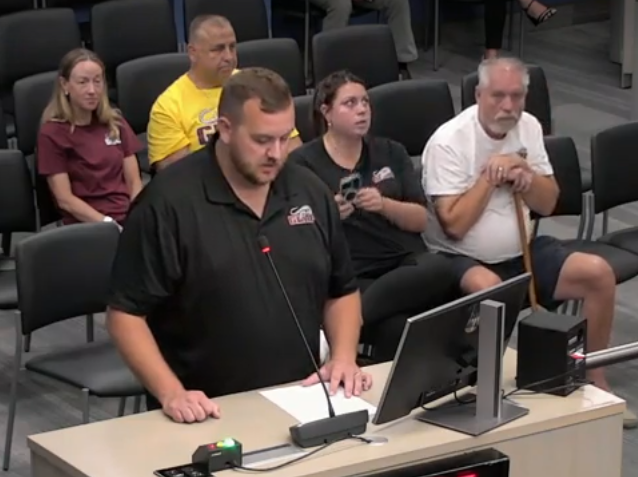 Cory Bradt with GHAC supporters addressing Council Rather, they are letters of record submitted in April 2025, as part of our formal bid document. They were included to provide facts about our organization, that the Golden Horseshoe Aquatic Club is a member in good standing with both swim Ontario and swimming Canada, that we are actively engaged in the betterment of our sport at the local, provincial and national levels, and that inclusivity and athlete centered programming are long standing principles at the heart of GHAC.
These letters speak to our values, our track record and our commitment to creating safe, welcoming and high performance environments for all swimmers, and that’s what they’re intended to do, and that’s exactly how they should be read. I’d like to take a moment to speak about the strength of our coaching staff, because when it comes to athlete development and a quality experience here in Burlington, coaching matters at the Golden Horseshoe Aquatic Club. We are proud to have some of the most qualified and respected coaches in the province. A few highlights of this past year alone, two of our coaches received world class performance coaching awards for coaching an athlete ranked in the top five globally, and we’re proud to have the OUA women’s coach of the year on staff leading one of Canada’s most successful university programs when it comes to certification, we have three fully certified level three coaches, the highest level of coaching certification in Canada, leading Para program.
We also have a growing team of level two and level one coaches who are certified, trained or actively working through that process. But these aren’t just titles. They represent our deep commitment to safe sport, athlete well-being and a culture of excellence that supports every swimmer from their first stroke to the national and international stage, that commitment to excellence shines through in our athletes as well. G hack is proud to be home to four members of Team Ontario, three swimmers and one coach who have been selected to represent the province the Canada Summer Games later this year in St John’s. That is the most from any club or any program in the entire province, and all four of those members have benefited from training and coaching within city limits, and over the years, more than 200 GX swimmers have gone on to compete at colleges and universities across North America, a testament to the pathways we create and the legacy we continue to build.
I would be remiss if I didn’t acknowledge the broader issue that brings us here today, the critical shortage of aquatic infrastructure in Burlington, Canada’s most livable city. Quite simply, this community needs more aquatic infrastructure and space. A 50 meter pool is not a luxury. It is a necessity for recreation, for learn, to swim programs, for accessibility and for a healthy, active future, let alone the sport tourism impacts that competitive swim brings to this community. I want to share that the aquatic Sport Council of Ontario has produced a white paper titled building more aquatic centers in Ontario, a practical and forward looking document that supports government and industry stakeholders for planning the province’s aquatic infrastructure needs. Burlington deserves to be part of that future. I will share that publication with your offices, for you to review that needs to be part of this bigger conversation on behalf of our coaches, our athletes and our families. Thank you again for the opportunity to speak today, we remain committed to working collaboratively with the city to ensure that competitive youth swimming is inclusive, high quality, and firmly focused on what’s best for our young people. Thank you.
Mayor Meed Ward: You do have a couple of questions coming to you.
Councillor Stolte: I wanted to ask you a question about that lack of aquatic space, and what your thoughts are for the club that you are such an integral part of, is that you spoke of being very resourceful, and I admire that, that over the last five years, you were able to find space at the YMCA and goldfish, I think you mentioned, yeah, another private facility here in Burlington. Is it your intention to maintain those contracts as well as utilize the city pools, or would you be moving your swim program into the city pools, and would free up that other aquatic space?
Cody Bradt: : I can’t speak to that particularly based on what we don’t know what Pool time we have available from the city. So what those hours are, depending on what’s available to us and how it best suits the interest of Burlington residents will depend on whether or not we continue to use private facilities and the manner in which we’ve been doing okay.
Councillor Kearns: My apologies. I’m joining you from Joe Brant Fracture Clinic with my 14 year old. I want to ask if you feel that there is a possible path to the delegate to allow both organizations to operate in the city of Burlington. Yes or No,
Cody Bradt: I think that if the city prepares in writing a process forward, it would be something that certainly we will take back to our team and our legal counsel as a path forward.
FIX Councilor Bentivegna: I appreciate everything you do for the community. I want to follow up on the question Councillor Kearns raised about other organizations in the city have in the same situation that you’re in, facilities are always an issue. We never have enough. I’m familiar, and I’ve been part of in the past, working with the city and other organizations in that sport to build facilities. Are you familiar with this sort of a discussion or potentially a debenture to build a new pool, for example, with the organizations in the swimming fix?
Cody Bradt: Absolutely, while we talk about other resources and the scarcity of it, nothing is more scarce than aquatics, right? Aquatics are used by the greatest range of population, of constituents of the City of Burlington, compared to our baseball diamonds, our soccer fields and other city amenities. GHAC would be proud to be a part of that conversation moving forward. And it is a not only a municipal issue, but a provincial issue and a national issue, FIX It’s created more effective use of space, but it doesn’t necessarily mean that we’re able to get that many more people that we would with the new facilities. So absolutely, and the white paper done by the Aquatic Council of Ontario, and I know swim Ontario and swim Canada is certainly willing to be part of that conversation with the municipality
Bentivegna: Would you be willing to sit down with other members in this sport to sort of say, let’s all get together and think about what how we can do this and then approach the city?
CodyBradt: Absolutely, we would be willing to work together with that. I think that there are a lot of user groups within the city that would benefit from new aquatic infrastructure, ranging from other competitive youth swimming providers, masters programs, diving Synchro. And I think that a collaborative approach to Council and the importance of aquatic infrastructure would be certainly beneficial.
Councillor Sharman: You raise an extremely important point, which, of course, is the lack capacity. I don’t know the numbers. Presumably you don’t know in terms of how many pools, how many? I don’t know what you wouldn’t measure it by square feet or square meters or cubic meters, but if you were to think about in terms of what we have versus what we need now and what we might need in the future, in terms of basically number of pools, do we need 50% more or 100% more. What are we talking
Cody Bradt: Speaker I think that the first part that needs to be looked at is an indoor, long course, 50 meter pool; that is the Olympic distance that we currently don’t have in the city of Burlington. And if you look around the region, there’s nothing but aging facilities that provide that service to our members, but that is raced up at the international level and provincially and nationally, and I think that it has to be part of a greater picture of what Council and its constituents within their wards want for this city and the sport tourism impact that can be brought because that makes a big part of “Hey, we’re going to build a 10 Lane, 50 meter pool that is a flat bottom depth that we saw, or we see at some pools across the nation. But that doesn’t necessarily allow you to have learn to swim programs at a flat bottom depth.
That means provincial and national and world regulatory specifications. So it needs to be looked at what it needs to be used for, and does it have a movable bottom? Look at what the city of Windsor did, and they have a beautiful facility down on the waterfront that has a movable bottom that they’re able to utilize for different user groups, depending on what is required, and that’s just one piece. But it’s also looking at how many stands need to be. What does the city want to host? Do they want to host a provincial championship that currently has 1500 participants plus in Toronto, that keeps getting pushed back to Scarborough or Windsor outside of our community because we don’t have the infrastructure for it, because I can speak to an event we hosted this year that had hundreds of people participating, but not only as swimmers, as family members, buying and spending money, buying goods and spending money in those cities, And the more heads and beds we can get in this city, and in correlation with competitive swimming, I think, will really help Burlington grow as a community.
And it’s important to note that when this conversation happened five years ago in the 2020, RFP process, the Centennial pool had different rules and regulations surrounding the number of spectators and the participants on the deck level. That has since changed, which inhibits the max number of participation, bringing less tourism dollars to the city and less participation by youth, and that’s nothing beyond like that’s all beyond our control, because it’s fire regulations, etc, but that’s just a piece that we’ve lost. Well, we haven’t lost the lane space. We’ve lost the infrastructure space to support the sport tourism that once existed in this great city.
Sharman: I appreciate the answer, and I it’s clear what you’re saying is, just like many things in the city, we need more and more and more and more. The big, big question, though, and you’ve already said that you think there needs to be a collaborative relationship to serve the members of the community that we have a shortage, and somehow we have to fight figure out how to make that work. Is that your point?
Cody Bradt: Absolutely. We have to figure out how to make it work. And the youth of Burlington and making an inclusive, accessible sport available to our young people is at the heart of what we did in this city, owned facilities, 2009 to 2020 and what we’ve done outside of that 2020, through 2025, and I think that that need is not any like that was pressing in 2020 when we lost out and had 1000s of opportunities missed for people to understand and get to participate in what makes our organization great. And I think it’s an important conversation that we need to have to continue moving forward, but the framework that we currently have set out is a formal RFP process that has a signed contract and that will be on the city to come back in writing what they’re proposing needs to be done.
Mayor Meed Ward: Not seeing any other hands, so I’ll jump in with a couple of questions. I was very interested to read about the Para swimmer program in your letter mention the 13 para swimmers. Are those all the Burlington residents?
Cody Bradt: They’re not all in that program, because we are the one of the only programs in the province that we are the only program in the province that has that many swimmers at that level. So we have people driving all the way from North York and Vaughn to be a part of our program. And you can see that later in the letters. So a number of those people listed in Para swimmers are Burlington residents, but they haven’t had the opportunity to be part of accessible programming for competitive youth swimming for children with visual, intellectual or physical disabilities in the past five years.
So the number isn’t a direct reflection of our organization, but the lack of opportunity we had within city of Burlington owned facilities to offer our program, which we did offer, pre 2020, and actually a national champion, a the swimmer that was mentioned in my presentation, that was ranked top five globally last year, grew up learning how to swim in City of Burlington, pools down in Aldershot, and I can remember him being this big, and this week he’ll present. He will raise provincials, and five of the members grew up swimming in our programs here in Burlington, within city limits. And then there are a number of young people that have since reached out and joined us at other facilities, because it didn’t exist with other organizations within city limits.
Mayor Meed Ward: I am interested in this notion of the need for a 50 meter pool, which has recently come on my radar. Iyou may be aware that Mississauga Council, somebody notified me that their council did a resolution very recently, probably as a result of the Aquatic Council of Ontario white paper saying that there needs to be indoor 50 meter and asking for provincial and federal assistance. We do have two 50 meter pools, or outdoor Nelson and mountainside, and I know they’re used for meats in season, so I don’t know if sticking a dome on there would help make it all season, but, but we do have the two, at least during the summer. I’m very interested to get the paper. Do you think that that would be something that this council should explore is what, what Mississauga and others are doing to advocate to for assistance in adding more aquatic facilities?
The following was not part of the CHAC delegation. We added the information so that readers could have an idea of what the Mayor was talking about when she asked about a bigger swimming pool
The Windsor International Aquatic and Training Centre (WIATC) in Windsor, Ontario, features a 50-meter competition pool. This state-of-the-art facility, located at the Family Aquatic Complex, also includes a diving well and a leisure waterpark area. The 50-meter pool is part of a larger 71-meter by 25-meter pool with 10 lanes, and it can be reconfigured using movable bulkheads and a movable floor.
 A ten lane swimming pool with a movable bottom that would accommodate diving events also has a viewing stand is on the Mayors radar. CodyBradt: Absolutely. I think that that needs to be a broader conversation. I know that a formal RFP process brought it, brought us here, and has opened that conversation to move forward. And I think it’s a great gateway, and I think that we need it in our city. I would note that the pool at Mountainside is not suitable to competitive swimming, in the sense that you’re not able to host competitions because it’s only three lanes and it’s in a small section, whereas Nelson was able to have that great outdoor meet and have that great community impact.
The piece that is interesting that you bring up about domain, which we’ve thrown around in our own conversations in the past, is that, well, a dome is its own entity in and of itself, and I want this council to evaluate the air quality and the importance of managing the chloramines, etc, within doming a facility. That ability to evaluate that air flow and structure is something that’s really important, and one of the reasons that existing long course facilities in this province have lost the opportunity to host provincial championships because the air quality doesn’t meet the needs of the sport or best supporting the health of our youth. So I know that the city has made a great deal of improvements in infrastructure within the city facilities and Victor and his team have worked very hard to update that system and go away from liquid chlorine and those elements, but I think that that broader conversation, we need a committed indoor, 50 meter pool that can be year used year round, that not only provides 10 lanes worth of space, but if you have 10 lanes worth of space in 50 meters, that’s 20 Lane short course which all of our other city facilities are. So that aquatic infrastructure is just that much greater. And you have seen it work in other municipalities such as the city of Markham that had the TORONTO Pan Am sports center built, where multiple user groups exist at the same time in competitive swimming to share Lane space within those 20 lanes. So it is being done around the province, and I believe that the aquatic community here in Burlington could work together to make that happen.
Councillor Kearns: One piece I’m still not completely clear on is, you know, with the ability to access these additional hours and lanes and uses, who are the athletes that will be using the pools? Are they existing competitive swimmers in Burlington that will change teams? Or are you going to help the people who are swimming in Vaughan to come in? I’m not sure what the scale up looks like, and I just wanted some additional clarity on that.
CodyBradt: Absolutely. That’s a great Parr the piece of it that is important to note is that the contract that we have signed with the city requires 85% Burlington residents, and we are committed to remaining with that so 85% at minimum will be Burlington residents, where those 50 though that extra 15% comes from we see reach from Oakville, from Milton, from Hamilton, which exists in both organizations as provided by the statistics that you requested from some Ontario and were provided to Council and the public. So I think that G hack is committed to supporting both of the existing competitive swimmers that are in the city and youth that are going to be new to the sport, and going from city programming to the great sport of competitive swimming.
Councillor Kearns: Okay, so just if I could be really blunt and clear, so is the scale up intention to pretty much bring most of the BAD swimmers under the GHAC umbrella, or is there another cohort that we don’t have visibility to that are waiting to get into the GHAC program with this potential new opportunity?
Cody Bradt: I can only speak to our program specifically that we have members that currently aren’t able to access our programs and want to be a part of G hack because we’re using outside facilities, as I mentioned the other day, that are not at ideal prime times for youth. So yes, there is a demand for our programs here in the city, and we prior to 2020 the incumbent organization had approximately, and I’m going to use approximate figures, we had 275 kind of on both sides swimming here in Burlington.
And so that’s 550 youth using competitive swimming as their sport in the city of Burlington. And at City of Burlington owned facilities, because we only had a handful of hours at a private facility here in Burlington, pre 2020, so those numbers have actually diminished the utilization rate of competitive swimming in the city within city owned facilities. And that number, those statistics, are provided every year by swim Ontario, as to how many people are registered within each organization, and that we go from 550 and now we’re talking about the number that has been publicly shared is in that realm of 400 within city of Burlington owned facilities. Well, that’s a far cry from the 550 approximately that used to exist.
Mayor Meed Ward: I am not seeing any other questions, so thank you for coming again this morning, and we will now move to the discussion of the item: a confidential verbal update regarding potential litigation for aquatics. We will be moving into close to discuss that. I have a motion from councilor Pennsylvania, seconded by councilor Galbraith that the special meeting of council proceed into close to receive confidential verbal verbal update regarding potential litigation for aquatics procurement in accordance with the following provisions under the municipal act, pursuant to section 239, 2e litigation, or potential litigation, including matters before administrative tribunals affecting the municipality or local board, and pursuant to section 239, 2f advice that is subject to solicitor client privilege, including communications necessary for that purpose regarding item 10.1, and I’ll turn it now to the clerk for the recorded vote. Unless there are any questions or comments from Council on that, okay, not seeing any, we will move into the vote.
That’s six in favour, and that does carry. We are now moving into closed session. Folks who shouldn’t be here kindly move into the lobby.
We will update, folks, as soon as we can, if there’s anything to update you on.

 By Pepper Parr By Pepper Parr
July 10th, 2025
BURLINGTON, ON
What happened at the Special meeting of Council this morning?
Nothing – they were there to discuss the a litigation matter – and that they did behind closed doors.
Before they went into Closed they heard from Golden Horseshoe Aquatic Club (GHAC) , who submitted some additional documents.
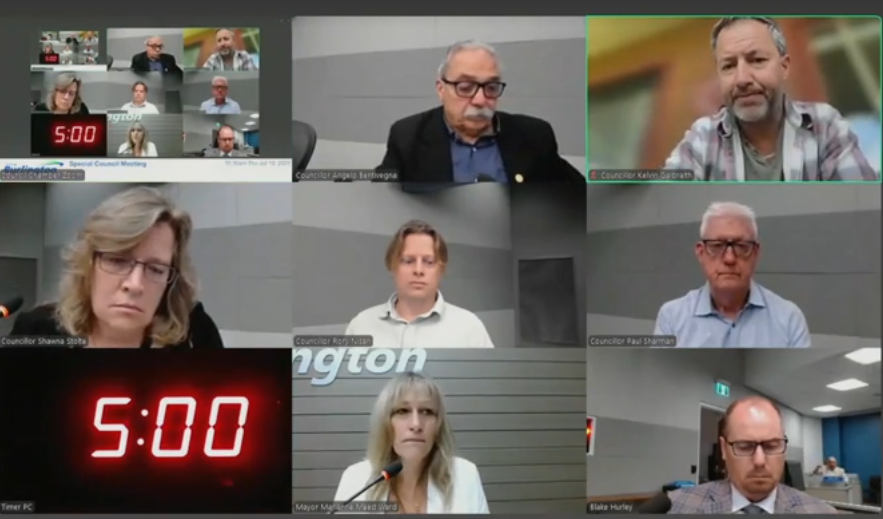 Do you see any smile on those faces? Council now knows just what the legal predicament is – and they need to find a way to wiggle out of it. They talked about the need for a 50-metre covered swimming pool with ten lanes and seating for spectators, with a couple of members of council agreeing.
Before adjourning Mayor Meed Ward said when there was something to report, she would ensure the public is informed.
This meeting was to assess the damage that resulted from the mishandling of an RFP approach to allocating the existing pool capacity in the city.
They are in a bind: GHOC claims they have a “a signed contract” which may not be the case. There were conditions to the agreement and there is no certainty that GHAC will actually meet those conditions.
Later in the day, we will have a more fulsome report which will include a couple of questions from Councillor Kearns, who unfortunately had to tend to a family matter; one of her children took a tumble and is now wearing a sling.
The look on the faces of most of the Councillors as the vote to adjourn was taking place was that of a pretty glum bunch.

 By Pepper Parr By Pepper Parr
July 10th, 2025
BURLINGTON, ON
Editorial Opinion
At 9:00 am this morning Mayor Marianne Meed Ward will call a Special Council meeting to order and have the Clerk do a role call to ensure there is a quorum.
Will ward 1 Councillor Galbraith attend virtually or will he be in the room to be part of whatever vibe there is going to be.
Will CAO Hassaan Basit be in the room – he did not take part in the last Standing Committee or the last Special Council meeting. He walks out of City Hall on the 4th of August after just 16 months in the job.
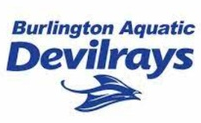 The understanding we have is that Council will go into a Closed Session – there is the suspicion that someone has taken legal action – Burlington Aquatic Devilrays (BAD) has said they have put their request for a Judicial Review on hold until they have a better understanding of what Council is going to do. The understanding we have is that Council will go into a Closed Session – there is the suspicion that someone has taken legal action – Burlington Aquatic Devilrays (BAD) has said they have put their request for a Judicial Review on hold until they have a better understanding of what Council is going to do.
There is no word on what Golden Horseshoe Aquatic Club (GHAC) intends to do. From a media perspective, GHAC has gone mute.
What seems to have been lost here is that the seven members of Council were elected to serve the needs of the 194,000 citizens of the city. The city has just the one swimming club that offers a program that focuses on training and sponsoring competitive events.
For reasons that have yet to be explained, City Hall decided that a Request for Proposal format was to be used to determine who would offer the swimming program. That RFP didn’t limit applicants to city based organizations.
Some feel that the city funding should be open to anyone. That would be fair, some have said.
What has fairness got to do with it? There is a Burlington organization that has delivered a service to swimmers for four decades in place and they seem to be doing a good job. If the delegations made by Katie Lebel and Pam Pritz SPELL are an accurate reflection of the quality of the club management, the city is lucky to have them.
Being fair and allowing some other organization to submit a bid that would kill the BAD organization is fair to who?
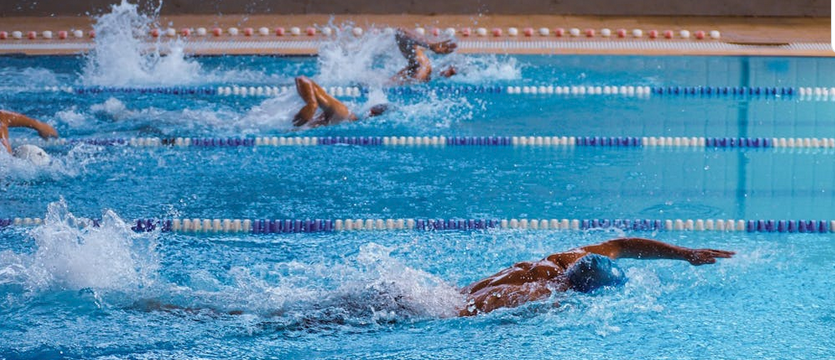 The city administration lost sight of what was taking place: This was about sports, not which procedure was used to determine which club would provide the services to swimmers. GHAC is focused on growth – nothing wrong with that – but is organizational growth going to be what kills a swimming club that has served the city exceptionally well if the number of people who attended the Council meeting last week is any indication. Is BAD perfect – of course it isn’t.
One of the things the city could/should do is hire an independent organization (not people from the Parks and Recreation department – they should be part of the review ) to do a deep internal review on the effectiveness of BAD. Every organization needs oversight. The City Auditor could be tasked to get something like this done.
There is close to $250,000 on the table. This is taxpayer money – it should be spent on Burlington organizations and not on an organization that has programs in numerous locations in the GTHA.
 GHAC said they are not a Hamilton swimming club – then what are they? GHAC said they are not a Hamilton swimming club – then what are they?
Burlington might want to give some consideration to help funding a second swim team; the city also has to look at its inventory of swimming pools.
This egg on everyone’s face is embarrassing for everyone. We are, or we should be, better than this.
Council has to ensure that all the facts are on the table, including who did what and why.
It is clear now that the RFP approach was a mistake – who made that decision?
Everything City Hall does is political – senior people are expected to be conscious of the political impact on the decisions they make.
That does not mean what they do should be driven by a political agenda – that is what Council members are in place for.
Why the current CAO was not involved and why the treasurer wasn’t at least made aware of what was happening is something the public may never know – and that would be unfortunate.
Marianne Meed Ward turned herself into a very effective council member on the two words: accountable and transparent.
Her grip on those two words is less than it once was.

 By Sidsel Nørgaard By Sidsel Nørgaard
June 10th, 2025
BURLINGTON, ON
Live dealer games are transforming the casino landscape by offering players an immersive and interactive experience. With advancements in technology, these games have seen significant growth and popularity. Pistolo plays a key role in this evolving market, reflecting broader trends without overt promotion. Additionally, Online Casino Pistolo continues to illustrate the shift toward more interactive gaming experiences.
 Pistolo offers a glimpse of how interactive features enhance overall engagement. The world of online casinos has experienced a remarkable evolution with the rise of live dealer games. These games have captured the interest of players looking for an authentic casino experience from the comfort of their homes. Online Casino Pistolo exemplifies this evolution, offering a glimpse of how interactive features enhance overall engagement. The allure lies in their ability to replicate the thrill of a physical casino through real-time interactions with professional dealers. As we explore the trends shaping live casino gaming in 2025, it’s evident that technological advancements are at the forefront, enhancing both gameplay and player satisfaction.
Technological Advancements
Innovations in streaming technology have significantly improved the quality of live dealer games. Players now enjoy high-definition video feeds that make them feel as though they are sitting at an actual casino table. This improvement in visual quality is complemented by enhanced interactive features that allow players to communicate directly with dealers and other participants. Such features not only enrich the gaming experience but also foster a sense of community among players.
 The integration of cutting-edge technology has made these games more engaging and realistic than ever before. The integration of cutting-edge technology has made these games more engaging and realistic than ever before. Augmented reality elements are beginning to emerge, providing an even more immersive environment. Additionally, advanced software ensures that game outcomes are fair and transparent, building trust among players and maintaining integrity within the gaming industry.
Pistolo is among the platforms that have adeptly adapted to these technological shifts, positioning itself within this dynamic landscape. By embracing these advancements, Pistolo enhances its offerings while aligning itself with industry trends that prioritize player engagement and satisfaction. Moreover, Online Casino Pistolo reflects these innovations by continually evolving its interactive features.
Pistolo’s Market Context
Within the broader market context, Pistolo stands out as a participant keenly aware of live casino gaming trends. Although not overtly promotional, its presence reflects an understanding of what modern players seek: authenticity and interaction. The platform integrates innovative features that cater to these desires, ensuring it remains relevant amidst evolving industry standards.
The role of Pistolo extends beyond mere participation; it actively contributes to shaping the future direction of live dealer games. By incorporating user feedback and staying abreast of technological developments, Pistolo remains a vital component in this ever-changing sector.
As live casino gaming continues to evolve, platforms like Pistolo are crucial in meeting player expectations and delivering exceptional experiences. Online Casino Pistolo also contributes to this evolution by constantly refining technologies to meet various player demands. Their ability to adapt and innovate secures their position as leaders within this vibrant industry.
Player Engagement
 Your dealer is right there in front of you – other players at the table can be seen in the screens behind the dealer. The appeal of live dealer games lies in their capacity to offer an engaging and social gaming environment. Players are drawn to the opportunity for real-time interaction with dealers and fellow participants, which enhances the overall experience. This level of engagement is particularly appealing to those seeking more than just a solitary online game session.
Social elements such as chat features allow for conversations between players and dealers, adding a personal touch that is often missing from traditional online games. This interactivity fosters a sense of camaraderie and competition, making each gaming session unique and memorable.
The immersive nature of these games also attracts new demographics who appreciate the blend of technology and human interaction. As more players discover this engaging format, live dealer games continue to gain traction within the broader online casino market.
Future Outlook
The future of live casino gaming looks promising with continued technological advancements on the horizon. Players can expect even more sophisticated features such as virtual reality integrations, which will further enhance the realism of these games. As platforms like Pistolo continue to innovate, they will undoubtedly lead the way in setting new standards for player experience.
Furthermore, increased customization options will allow players to tailor their gaming environments according to personal preferences, making each session uniquely enjoyable. This flexibility will likely attract a wider audience looking for personalized entertainment options.
In conclusion, live dealer games represent a significant trend within the online casino industry that shows no signs of slowing down. As we look ahead to 2025 and beyond, it’s clear that platforms embracing innovation while prioritizing player engagement will thrive in this competitive landscape.

 By Pepper Parr By Pepper Parr
June 8tjh, 2025
BURLINGTON, ON
I was about to write a piece on the failure on the part of City Council to address the problems behind the swimming pool allocation problem involving two swimming clubs; The Burlington Aquatic Deveilrays (BAD) and the Golden Horseshoe Aquatic Club (GHAC), when the Mayor announces that she has called a Special Council meeting to take place on Thursday at 9:00 am.
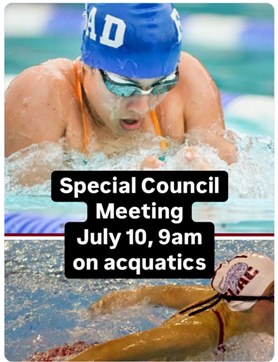 The Mayor didn’t say a word about this during the Standing Committee that adjourned at 2:15 this afternoon – nor was there any mention at the Special Council meeting that took place immediately after the Standing Committee. The Mayor didn’t say a word about this during the Standing Committee that adjourned at 2:15 this afternoon – nor was there any mention at the Special Council meeting that took place immediately after the Standing Committee.
Hopefuly, the city staff members that made some of the decisions will be asked to explain what they did. We would like to hear from the City Treasurer Craig Millar, the Director of Parks Recreation and Culture Emilie Cote on why she chose to send the issues to City staff who were asked to issue a Request for Proposal (RFP) and where the Chief Administrative Officer was when all this was happening.
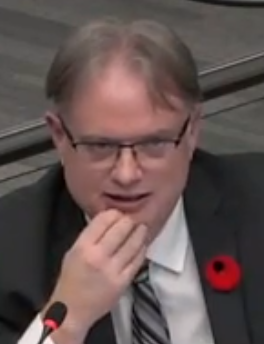 City Treasurer Craig Millar 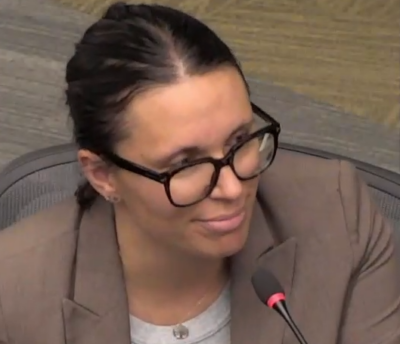 Director of Parks, Recreation and Culture Emilie Cote 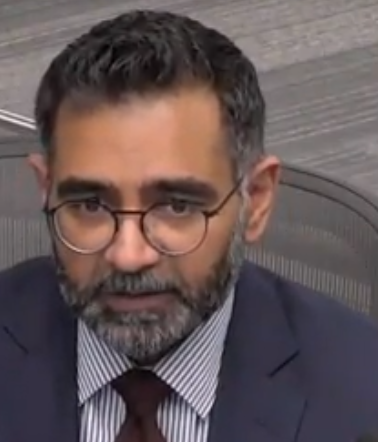 Chief Administrative Officer Hassaan Basit The public deserved to be told where the city failed at both transparency and accountability.
Mayor Meed Ward does deserve credit for calling the meeting. Let’s expect that the kimonos will be wide open.
 Marianne Meed Ward delegating before City Council Is Mayor Meed WArd returning to her transparency and accountability roots?
After publishing news of the Special Council meeting we went looking for the agenda.
Here is what we found:
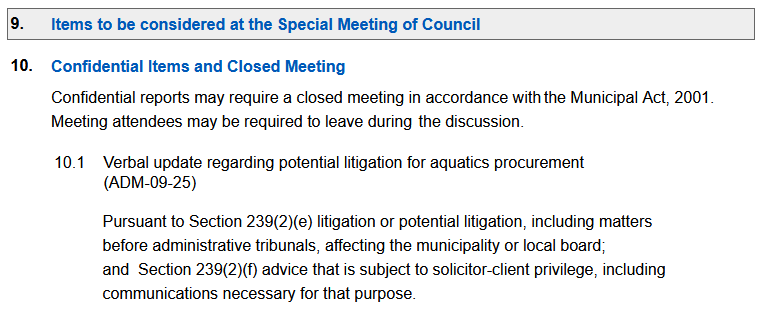
As soon as the meeting begins Council will go into a Closed Session, which means viewers will be looking at a notice. When the Closed session ends Counil might say what took place in the meeting.
This isn’t a meeting to inform the public – this is a meeting at which council will try and figure out of the hole they are in.
When you are in a hole you dug for yourself – rule 1 – STOP digging

 By Pepper Parr By Pepper Parr
July 8th, 2025
BURLINGTON, ON
Kimberly Calderbank delegated at City Hall on the decision made to award swimming pool allocation to the Golden Horse Aquatic Club, during which she set out how she understands this decision came about.
Good morning, Mayor Meed Ward, and members of Council.
My name is Kimberly Calderbank, and I have the privilege of serving as President of the Burlington Aquatic Devilrays. I am not only a volunteer president, but a Burlington parent. My son, who is 14, and my daughter, who is 10, both swim with BAD. Through this club they have learned what it means to work hard, to show up for others, to be resilient, and to believe in themselves.
We know how deeply each of you cares about Burlington families. And we are grateful for your time, your service, and your commitment to a strong, inclusive city.
You’ve already heard from two powerful voices today:
First, from Katie, a Burlington parent and professor whose story reflects the kind of legacy our club
represents—and the broader system-level implications of this decision.
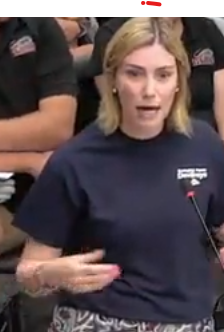 Calderbank: It asked applicants to demonstrate how they would deliver high-quality programming for Burlington youth. Our club is already doing exactly that And second, from one of our young athletes—who showed incredible courage by coming here this morning. His story reminds us of what’s really at stake: the well-being of the kids at the heart of it all.
I want to speak on behalf of our board, our leadership team, and the 400 families we serve—and I want to begin with a point of clarification around residency.
The City’s RFP was clear: this contract should prioritize Burlington families. It asked applicants to demonstrate how they would deliver high-quality programming for Burlington youth.
Our club is already doing exactly that. We serve more than 320 Burlington swimmers across our competitive and pre-competitive programs. These are not projections. These are kids who live here, go to school here, and have built a community here.
In contrast, the club awarded the contract is not Burlington-based. According to Ontario’s Not-for- Profit registry and Swim Ontario, they are listed as a Dundas club, operating in the Hamilton region. To our knowledge, they have not followed Swim Ontario’s standard process for regional expansion— one that requires input from local clubs like ours.
And this is not an isolated case. GHAC has been expanding into multiple municipalities across the region—reflecting a shift toward a regional, market-based model that prioritizes growth and scalability. That model may suit some programming contexts, but it raises real concerns when City- owned public infrastructure is allocated without fully considering community roots, local access, or long-term partnership history.
Their bid appears to have been evaluated as if they already operate a Burlington-based program— despite lacking local governance recognition or an established base here. Even if they were to absorb our entire club tomorrow, they still wouldn’t serve as many Burlington families as we already do today.
This isn’t just about numbers. It’s about transparency, process, and purpose. The RFP was designed to prioritize Burlington kids. But the outcome, however unintended, doesn’t reflect that goal.
That’s why we appreciated the opportunity to meet with City staff last week. It was a productive and respectful conversation, and we’re grateful to have had the chance to engage directly and clarify some of these points.
As you know, we’ve asked for 40 hours of pool time to keep our club operational this fall. That number reflects the minimum required hours to prevent further damage to our programming, our coaching, and most importantly, our athletes.
These are not empty hours. They’re carefully structured training blocks that allow us to serve a full range of swimmers from pre-competitive swimmers just learning the ropes, to senior athletes training for provincial and national goals.
With less than 40 hours, we would be forced to cut full training groups, turn away families, and potentially lose coaches who rely on consistent scheduling to sustain their livelihoods. This threatens the viability of our club.
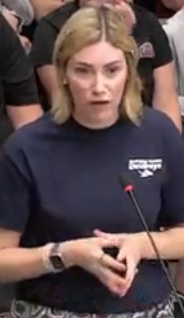 We’re not just a swim club—we’re a development pathway. BAD is more than a swim team. It is a community. It is where families run the Terry Fox Run together, gather donations for the local food bank, and collect warm socks for neighbours in need.
We’re not just a swim club—we’re a development pathway. For 40 years, BAD has nurtured swimmers from their very first strokes to national and international success.
This year, Swim Ontario formally recognized the Burlington Aquatic Devilrays as a key contributor to Canada’s success on the world stage—specifically highlighting our role in supporting Katie Cosgriffe on her path to the 2024 Paralympic Games in Paris.
That recognition matters. It shows that what begins in community pools—volunteer-led, team-first, grassroots programs—can lead all the way to the podium. This is the kind of development system we should be protecting, not displacing.
More than 2,000 residents have signed our petition. Support continues to pour in from alumni, fellow clubs, and Burlington families who want to see this club protected.
Every day that goes by without clarity, we lose more swimmers. Coaches can’t plan. Families can’t register. Athletes lose momentum and stability.
While we are deeply disappointed in how this process unfolded, we are not here today to rehash legal arguments. As you’ve heard, we’ve paused our judicial review in good faith—because we believe a shared solution is still possible.
And we believe that in youth sport, “do no harm” should be the baseline. We are not asking the Council to choose sides.
We are not asking for exclusivity.
We are asking for a fair and functional solution—one that reflects Burlington’s values and allows our 40-year legacy to continue.
We believe we can coexist with other user groups. We’ve always worked collaboratively and we remain open to shared solutions, so long as they allow our families to participate meaningfully and sustainably.
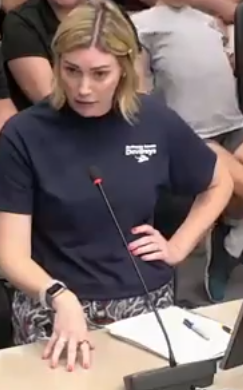 First, that the City allocate 40 hours of pool time to the Burlington Aquatic Devilrays this fall. So our ask is simple:
First, that the City allocate 40 hours of pool time to the Burlington Aquatic Devilrays this fall, concentrated in core training blocks that support effective training. These hours are essential not only for practices—but also for our ability to host swim meets, which provide critical revenue to keep our programs affordable and accessible. Swim meets are a tradition—they’re also a financial lifeline. They sustain our programming, strengthen our volunteer base, and bring families from across Ontario into Burlington. Removing our ability to host them threatens our long-term viability.
Second, that Council call for a formal review of how RFP’s are used in allocating youth sport resources—so future decisions better reflect the values of equity, community, and public good. And so that no club, no coach, no family, and no child has to go through something like this again. We wouldn’t wish this experience on anyone.
We’ve done our best to remain constructive, collaborative, and solutions-oriented. We’ve shown that we are willing to adapt, to share, and to meet the City halfway.
Now we ask that our City do the same.
Because the stakes are high—not just for our swimmers, but for what Burlington chooses to stand for.
Please don’t let our legacy end here. Help us ensure no swimmer is left behind, and that Burlington remains a place where community sport can thrive for generations to come.
Thank you again for your time, your leadership, and your dedication to Burlington.
It was now time for Council members to ask questions of Calderbank
Chair Lisa Kearns: Thank you very much for your delegation. We’re going to go to our list of speakers now.
Bentivegna: For our purposes. Swim, Ontario is a governing laws, and they create, obviously, rules and regulations for the whole province. Do they work on registration and residency by municipality or by name? How does that? Can you expand on how that gets so
Calderbank: Swim, Ontario is our regulatory body. So our insurance, all of our registration, everything happens through swim Ontario. So that’s sort of them than us. When you register a swimmer, you pay a fee to swim Ontario to register them. It’s certain laws, like a concussion law, all of those things, all the papers, legalities, are done through swim Ontario. So a fee goes to swim Ontario when our children register. Our registration fees are kept around 250 ish dollars. Some of that goes to swim Ontario. Some goes to help our club with the registration, Administrator, administration costs other local clubs, oak, for instance, can be upwards of $1,200 for registration. So it’s very different depending on what the club decides to do, but effectively, it’s paying a fee towards swim Ontario. When you register a swimmer, the family fills out where they live, address, contact information, all of that good stuff. So they are looking at the city with which that swimmer lives in for registration to Swim Ontario.
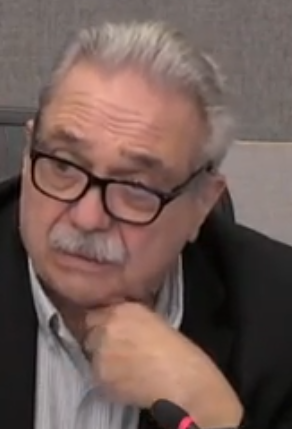 Ward 6 Councillor Angelo Bentivegna Bentivegna: Follow up on that. Kearns interjects: No, it’ll be a second question. You have a big list here, so it’ll be a second question. You are are using your second question now. Bentivegna: I can’t use a follow up for that? Kearns: No, because your first question was like six questions.
Bentivena: I guess my second question will be, how many swim organizations are there in Burlington, operate out of Burlington.
Calderbank: Currently the Burlington aquatic Devil Rays operates out of pool space. Here in Burlington, there are also private swim organizations that operate out of Cedar Springs. I believe goldfish has a club as well. So in private organizations, we also have a synchro team here in Burlington that I believe solely operates out of Angela, sorry, Aldershot, a very well known, popular, award winning Synchro club. And we also have a dive team here in Burlington, but from a swim club competitive perspective, that is the one that’s currently operating out of city facilities. Thank you.
Councillor Stolte: You mentioned about the request for 40 hours a week. How many hours a week were you accustomed to operating under?
Calderbank: The RFP itself was based on 2000 hours. So in the RFP, we had to show how we would use all 2000 hours. We actually had to cut back our program programming to be able to use the 50 hours that the RFP was looking at. So when we met with city staff last week, the conversation was, what do you need? And we sort of shifted it from what do you want to what do you need? Because we need the 40 hours to not have to cut we don’t want to do harm.
We want to keep the club as a whole, as was previously mentioned, we are losing swimmers day to day at this point because people are registering for other clubs. The fear is that piers also, sort of alluded to tryouts for other clubs have happened, right? Teams are built by this time in the past, when this RFP process happened in 2020 it was in the new year. It was earlier on in the season. So planning could go if you had given us 20 hours at that time, we had time to figure out what that looked like. At this point, I need to register swimmers, or I won’t have anybody left to register 50 would be the pie in the sky. The other thing that the contract and the RFP included was the Meet time, as I mentioned, those meets are our lifeline and how we exist that outdoor meet that Katie referenced we just had a couple weekends ago in June. We used to have clubs from Mexico come and join us. It’s a huge tourism piece. All of these families are staying. We had over 14 clubs and 1500 swimmers at that meet. So it’s a pretty impressive meet that we host at Nelson. That we’ve been doing year after year. Newfoundland was here again for the fourth year in a row. Their head coach loves it. He’s already emailed me. When can we come back? Those hours really matter to us to be able to continue along.
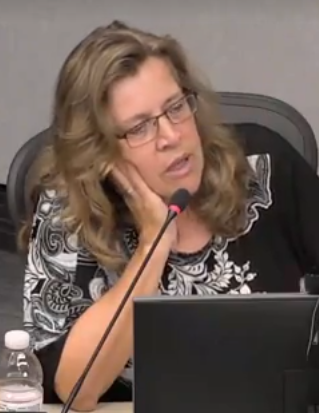 Stolte: Second question, so the 50 hours, in an ideal world that includes the Meet time, or meet times, the meat is part of sorry, the meat was part of the contract and the RFP, so it was the 50 hours, the 2000 plus, these are the meats that you would receive for part of the RFP,. Stolte: Second question, so the 50 hours, in an ideal world that includes the Meet time, or meet times, the meat is part of sorry, the meat was part of the contract and the RFP, so it was the 50 hours, the 2000 plus, these are the meats that you would receive for part of the RFP,.
Councillor Sharman: Thank you very much for being here this morning. Kimberly, I looked at the two websites, and I see you have three pools in Burlington on your website. But I also know that notice that GHAC has five pools in Burlington, but they’re also in five other Muse powers. You’re not in other Muse powers, correct?
Calderbank: We don’t have space anywhere else. So, based on the last RFP, previously, we also had access to Tansley woods, and we also had access to Aldershot. At one point, we’ve had access to other pools, as we’ve ebbed and flowed through the city, per the RFP last time, there were only certain pools that were allocated to that RFP, which is the same this time. So we’re bidding on access to Centennial Angela Coughlin and Nelson, essentially as part of the RFP process, which was part of the conversation with city staff last week was, can we access those other pools? I mentioned that we have Synchro and Aldershot. We have a dive club at Angela Coughlin. Are there ways to share the Pool time with them as well? But yes, my understanding is the website has since been updated since they received the RFP, and I do believe some of those Burlington pools have been on their website the entire time, even though they weren’t servicing out of them.
Sharman: That was was going to be my second question with respect to the five pools, and I’ll check it with the next delegation as well. That’s just been increased as a result of the result of the RP. Okay, so I’ll ask for more details. Thank you very much.
Councillor Galbraith attending virtually: Similar to Councillor Stolte, question around the 40 hours with the RFP being awarded to GHAC. What does that currently leave you with?
 Calderbank: None, zero. So the call that I had on June 5 with the procurement team was, we’ll follow up with the sustain, substantially reduced. I’m using air quotes. I don’t know if Calvin can see me or not, but substantially reduced. Okay, substantially reduced Pool time. I did not receive that call from the procurement team or the staff that day. It was promised by the end of the week. I did not hear by the end of that week, we did follow up and had a meeting last week with Emily Renee and a gentleman as well from facilities, and had that discussion. I’m quite hopeful that it will be more than the sustain substantially reduced time that I heard about on June 5. Calderbank: None, zero. So the call that I had on June 5 with the procurement team was, we’ll follow up with the sustain, substantially reduced. I’m using air quotes. I don’t know if Calvin can see me or not, but substantially reduced. Okay, substantially reduced Pool time. I did not receive that call from the procurement team or the staff that day. It was promised by the end of the week. I did not hear by the end of that week, we did follow up and had a meeting last week with Emily Renee and a gentleman as well from facilities, and had that discussion. I’m quite hopeful that it will be more than the sustain substantially reduced time that I heard about on June 5.
Galbraith: Thanks for that. And then second question, so when you’re talking 2000 hours and 40 hours, if you were awarded 40, what is that total? I assume the 2000 is the year correct total. So what does what does 40? Are you 40 per month? And that’s the work.
Calderbank: Yeah, we’re 480 as opposed to 2000 annually
Galbraith: So the ideal numbers, it’s hard to tell if he’s no, go ahead. I’m sorry. You’re frozen. Calvin, so it’s very difficult to tell if you’re speaking or not. I apologize for cutting you off. The 50 would be the ideal. Again, that helps us not have to secure private pool time. What we’ve been doing behind the scenes, trying to keep our members and keep pieces together is securing private pool time. So should we have to amplify or build in any extra time to be able to keep our club viable? We’re looking at ways to sort of beef that up. So again, when I met with city staff, it was a what you want, then turned into a what you need to really make it happen. And there are not a lot of private pools here in Burlington, right? There’s not pool infrastructure in Burlington, as I’m sure you’re all aware there, it’s there’s not a lot, there’s a lot of white papers going on around right now about how important Pool time and pool structure is. There is not a lot of accessible Pool time for us. So we went right down to looking at condos and apartments like we’re desperate to pull this together. It just doesn’t exist here in the city of Burlington.
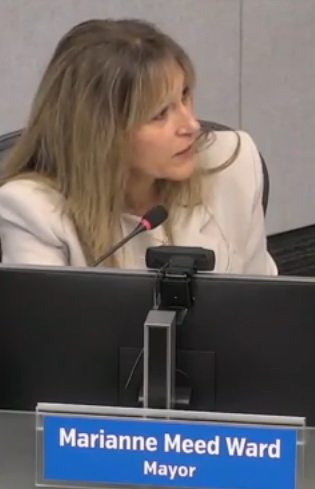 Mayor Mead Ward: Thank you so much for being here, all of you for being here. So you’ve raised some concerns, as did the previous. Delegate, I around the RFP as a method for allocating scarce Pool time or really limited hours in any city facility. She said the the RFP was akin to a construction contract, so perhaps really good for potholes, not so good for people, so what? And I noted it on your your slide that that you want a different path. Can you do you have any ideas or suggestions for us around how the city might fairly allocate a scarce resource full time, recognizing that there are Burlington families that do swim with G hack currently and travel outside the city. So we’ve got, we’ve got two clubs right now that that are providing really valued service to our residents. Mayor Mead Ward: Thank you so much for being here, all of you for being here. So you’ve raised some concerns, as did the previous. Delegate, I around the RFP as a method for allocating scarce Pool time or really limited hours in any city facility. She said the the RFP was akin to a construction contract, so perhaps really good for potholes, not so good for people, so what? And I noted it on your your slide that that you want a different path. Can you do you have any ideas or suggestions for us around how the city might fairly allocate a scarce resource full time, recognizing that there are Burlington families that do swim with G hack currently and travel outside the city. So we’ve got, we’ve got two clubs right now that that are providing really valued service to our residents.
Calderbank: I think what’s important first to acknowledge is the fact that G hack, as Paul mentioned, or councilor Sharman mentioned, has multiple facilities outside of Burlington. They’re already practicing in and that their club is already catching. They have not lost those facilities. To my knowledge, I’m sure they’ll speak to that we have without our facilities, we are no longer viable as a club with the Burlington pools. They just become a bigger a bigger club with more pools to practice in. There is a very vast difference between those two measures, right? One club ends because x and I understand that they have Burlington residents using those facilities. But again, if they were to take on all of our Burlington residents, they still don’t have the number that they need to be able to even stand close to what we’re servicing I mentioned for 50 hours and the wait list. We do have a wait list. We do have people that want to come and join us. Part of the RFP process in 2020 was starting our fundamentals and Learn to Swim program, which are now a splash and mini rate programs. So part of the request of the city was to add on Learn to Swim programs. So we were sort of filling that gap that the city has wait lists for themselves that takes up a significant amount of our pool users as well as our swimmers. But this is exactly how we’re growing people through our grassroots program. I would suggest that, as Katie had alluded to, a rental contract.
Mayor Meed Ward: So what do you what do you need, not what you want, and how are you going to make that viable and work it out?
Calderbank: I know that with our 400 swimmers, we’re strapped for the hours that we have. I’m interested to hear how and where we can’t access the information. How G hack, with their 100 and something, Burlington swimmers are going to use all of those hours for just Burlington swimmers. The math doesn’t math. For me, we need every last hour to be able to make that happen, and I believe that a rental contract is the way to go. The urgency is that if this isn’t happening, I don’t I don’t have a club to put to register daily. We are receiving withdrawals because people are going to other clubs. My son is swimming at OSC, that’s one of the biggest meets. We have several swimmers that are going out to one of our key swimmers left and registered with another club so that they could swim with them like it’s heartbreaking, and that is happening every day. So I know you’re not speaking about it till July 15, but that’s devastation. That’s another week.
Mayor: So would you advise our staff to sit down with swim providers to have this conversation and figure out a way forward? Is that the path that you’re asking us to do ?
Calderbank: The way I would have done it, and again, I don’t want an annual contract, because I don’t want to be back here next year doing this again. I think we know the pools that we have. We know the infrastructure that we own in Burlington here. I think it’s a matter of sitting down and finding out what the city needs for their programs and then what’s remaining. And then if you have G hack and you have bad and you have the synchro team, I apologize. I don’t know their name, the dive club. Sit down. How many hours do you need to help the Burlington residents make that happen and fill in the blank and schedule back? That’s how I would do it. And then I would be signing. It was a 40 page RFP, and it was multiple documents that we had to provide a ton of volunteer time, a ton of taxpayer time, a ton of resources went into this, and I don’t believe that needed to be the case. Okay? Thank you very much.
Chair Kearns: Thank you. I’ll take my first time question, then I see a second time question from Councillor Bentivegna. You may have seen from the press releases that council isn’t allowed to engage in the RFP or procurement process under our procurement by law. However, I believe Council holds a role in governance, and governance covers such issues as risk, financial liabilities, litigation liabilities, again, reputational liabilities, et cetera. So do you believe any of those conditions? Decisions are currently in play right now, so I can speak to that.
Calderbank: There were several steps that you could take through the RFP process to rebut or refute the decision. So when we found out on June 5, we had a small window to be able to ask for a review. The city then created a committee, which is quite interesting, because I believe several of the folks on there were actually parks and roads people are engineers, so not necessarily sport or community oriented people. So it was three staff at the City of Burlington who then emailed us back on June 24 I believe it was to let us know that no the decision was being upheld. From there, we did seek legal advice. Our lawyer has told us that we can take a step further, which is a judicial review, which is going to litigation, and going to court, and having court review the decision that was made and whether it was fair and just those are the two words that I keep using when I’m speaking with folks, that our lawyer uses, that we used when we spoke with the city last week.
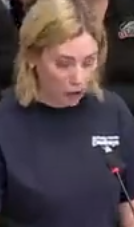 Was this decision fair and just? And everything in my fiber says this decision was not fair and just. And I’m sure everybody could agree, if you really took a look at it, it was not fair and just. So that is our next step in good faith, because I believe in this council, and I believe in the city, I’m hopeful that we can get what we need to altogether. So that review is on pause. I have a note to the lawyer. He was going to reach out to your legal team as well and advise that, as we are in negotiations or conversations here, that we have paused that, but it is something very real, and our club is willing to fight for these kids. Was this decision fair and just? And everything in my fiber says this decision was not fair and just. And I’m sure everybody could agree, if you really took a look at it, it was not fair and just. So that is our next step in good faith, because I believe in this council, and I believe in the city, I’m hopeful that we can get what we need to altogether. So that review is on pause. I have a note to the lawyer. He was going to reach out to your legal team as well and advise that, as we are in negotiations or conversations here, that we have paused that, but it is something very real, and our club is willing to fight for these kids.
It was at this point that Kimberly Calderbank began to lose it – some very deep breathing got her back to the point where she could continue.
Kearns: Thank you very much. My second question is in regards to the comment that you made about affordable and accessible as a club. So I heard you say it’s $250 to join the club or be a participant of the club registration. How was something like that evaluated or requested to be responded to in the RFP?
Calderbank: Yeah, excellent. So part of the RFP was to show a lay of the land of the fee structures through other clubs. So what is an environmental scan of what other clubs offer? And our club is a accessible, fair amount based on who is around us again. We have Oakville, we have GHAC, we have G hack. There’s some private clubs I mentioned as well. So right in the RFP document, there is a full chart that shows all of those pricing structures. Unfortunately, I don’t have in front of me that being said, RFP. Our RFP was not opened by staff. We were told, because we were rejected due to the language for the certificate, it was never opened, so nobody ever saw where our club stands against others.
Chair Kearns: Okay, thank you very much for that answer. Back to you, Councillor Bentivegna.
I just want to follow up on the mayor’s questions. Prior to 2020, this procurement process, you personally have 400 members a year. How many members would you had prior in 2020
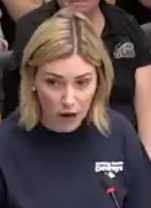 I’ve only been with the club since 2018 Calderbank: I’ve only been with the club since 2018 so I’m in a very new role. I couldn’t tell you specifically how many numbers our club continues to grow, though we see a continual growth a year to year. If we had more space, like I said, we would be, we would be using it. And it was a rental agreement in the past. To my understanding, it was not an RFP process. The first one was in 2020 both GHAC and BAD had applied to that RFP as well.
Betivegna: I’m more concerned about getting a number prior to rather than the growth side of it. Just to see, was it close to what you have now,
Calderbank: We’ve grown so I would have assumed we’d probably be around the 300 mark. I can certainly provide that to you afterwards as well, but we’ve grown substantially so over the over the years, yes, I will ask Jack and staff as well that question. So do you feel and I don’t can ask this question, or you’d be able to answer it. But do you feel that we may want to go back to that process prior to 2020?
Calderbank: I think it’s the only way to go back. Quite frankly, my understanding is a contract has been awarded. I think the only way to be fair to everybody and be just to everybody is to go back and start again. And that’s not an RFP process. I think that’s a sit down. What do you need? How can this work for you? How can we work together?
I understand that GHAC wants more pool space and wants time in Burlington, and I don’t want any child to be displaced. I want to make that clear. We’re not us against them at all, but I need all of the time for my swimmers here in Burlington as well, and our club, and we know the numbers we need, they know the numbers they need, and I think it’s just a negotiating of the time. I want to reiterate how important it is to understand that they are a multi regional Club, so they have space. So, heaven forbid they don’t have Burlington club space. Those Burlington swimmers have another pool to go to. They can drive down the street to Hamilton. They can go somewhere else. My swimmers cannot.
Chair Kearns: I think you have someone seeking your attention at the back. Oh no, oh no, oh no, no. It doesn’t work like that. No, no. Does not work like that. Nope you cannot do that. I thought you were trying to get the number to her, but if it’s not, you can whisper to each other for like one second. Turn around. Do you know the number to the answer?
Calderbank: It’s regarding the pricing and the structure that was available in the RFP, I think it’s been covered.
Chair Kearns: Thank you very much. You have no further questions. Thank you for your delegation.
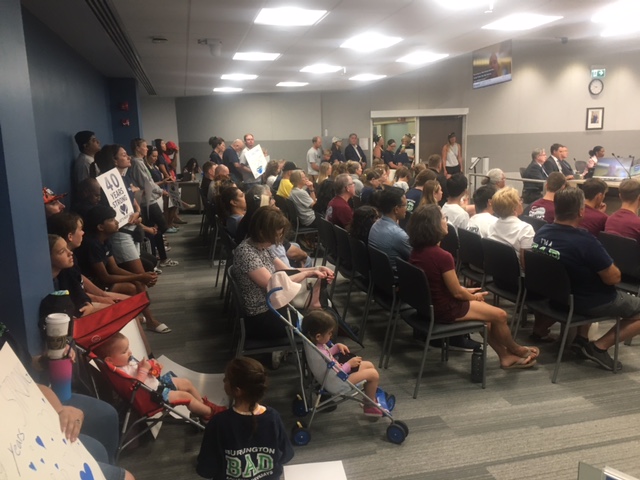 Standing room only with some people in the Council foyer And that was it. In a Council Chamber that was beyond standing room only Councillors heard a very sad story on how the administration chose to use the wrong procedure for what was a very simple problem: how do we allocate the available swimming pool time to the two organizations that want to teach and train young people how to swim for pleasure and as competitors.

 By Pepper Parr By Pepper Parr
July 8thth, 2025
BURLINGTON, ON
Katie Lebel delegated at City Hall on behalf of the Burlington Aquatic Devilrays
I’ve been asked to speak on behalf of the Burlington Aquatic Devilrays. I am a Burlington resident, a sport business professor, and the proud parent of a young swimmer on the team.
I’m also a former competitive swimmer. My sister and I grew up swimming under Head Coach Sergei Soloukhin more than 25 years ago. Now, I have the privilege of watching my daughter fall in love with the same sport—under the same coach who helped shape who I’ve become.
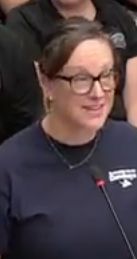 Katie Lebel I’ve delivered talks around the world on the power of sport. But I’m not sure I’ve ever spoken with more at stake than I do today. What’s at risk isn’t just pool time—it’s community, continuity, and the systems we count on to support our children and protect what matters in civic life.
We are here because we believe a better way forward is still possible.
While we did file for judicial review after our proposal was rejected without evaluation, we paused that process in good faith, because we believe a collaborative solution is still possible.
We’re not asking for special treatment. We are here to advocate for fairness, for transparency, and for a shared-use model that reflects Burlington’s values.
The Burlington Aquatic Devilrays is a not-for-profit, volunteer-led swim club with a 40-year history in this city. We serve over 400 swimmers from across Burlington and surrounding communities.
We’ve raised money for the Terry Fox Foundation, the Burlington Food Bank, and the Compassion Society. We don’t just use public resources—we help build and sustain them. We’ve welcomed national-level athletes and complete beginners. We’ve kept our programs affordable. And we’ve remained rooted in the community, season after season, for four decades.
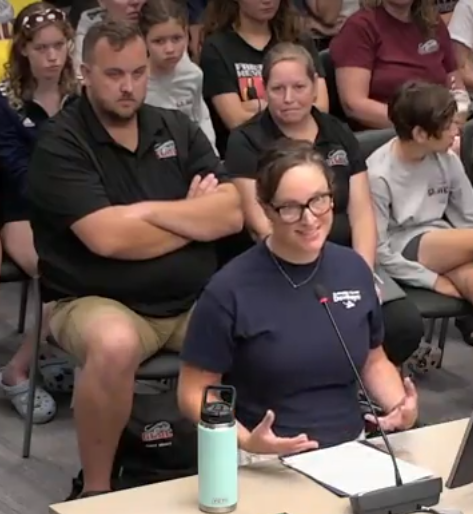 Katie Lebel delegating to Council for BAD. Sitting immediately behind her is Cody Bradt – Associate Head Coach & Chief Operating Officer who later delegated for the GHAC That legacy—everything we’ve built—was destabilized by a process that disqualified our proposal over a document that doesn’t exist in the form requested.
The language in the RFP asked for a “current and valid certificate of incorporation”—a document that, in Ontario, is not re-issued after initial incorporation. What’s typically used to verify legal status is a Certificate of Status or a Corporation Profile Report from Service Ontario. This technical ambiguity in language had real consequences: our proposal was rejected outright, without review.
The result was not a level playing field. It’s a signal that the process, while well- intentioned, may not be aligned with the realities of youth sport.
We met every substantive expectation laid out in the RFP, But we were disqualified before these strengths could even be considered or evaluated.
the RFP model is not designed to capture the depth of community relationships, the value of consistency for youth, or the contribution of legacy volunteer-run organizations. To our knowledge, competitive swimming is the only youth stream in Burlington currently operating under an RFP process. That fact alone suggests we need to stop and reconsider.
And all the while, time is running out.
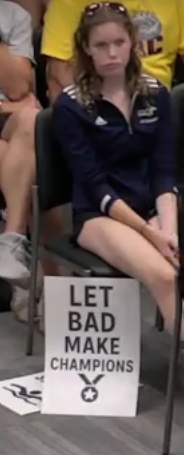 A BAD swimmer Every day that passes, more families leave. More swimmers ask if they’ll have a team. Our coaches can’t plan. Our registration is late. Just two weeks ago, our club was riding high.
We had just hosted two outdoor swim meets—one for our senior athletes, which welcomed 14 clubs, including one from Newfoundland. And another for our novice and precompetitive swimmers—just our own athletes—who got to experience the thrill of racing, many for the first time.
No child should ever have to worry about losing their community.
In youth sport, ‘do no harm’ should be the baseline. But when a team is destabilized— when kids lose their teammates, coaches, and training rhythm, the familiarity of practice sites—it’s the swimmers who feel it first. It shakes their confidence, interrupts their development, and undermines their sense of belonging.
Our senior swimmers train six days a week, often twice a day. They’re not just athletes, they’re leaders in our club who mentor younger teammates and help shape the club culture.
Disrupting those relationships carries real emotional and developmental cost.
Our club reputation, built over decades, has been put at risk by a process that did not allow us to be evaluated.
this decision didn’t happen in a vacuum. What’s unfolding here reflects a broader shift in how sport is being delivered across Canada.
Our club reflects a community model: affordable, team-based, volunteer-run, and grounded in long-term athlete development.
In contrast, we’re seeing the rise of market-based models—regional, fee-for-service programs that function more like private providers than community-rooted teams.
This isn’t just about two swim teams. It’s about two different visions for youth sport. One prioritizes access, development, and community.
The other prioritizes flexibility, expansion, and the ability to scale—at a significantly higher cost to families.
That’s not just a pricing issue—it’s an equity issue.
These are public pools, built with public dollars, meant to serve the public good.
If we allocate that space without factoring in cost and accessibility, we risk excluding the very kids who need it most. Let’s not make affordability the casualty of process.
Procurement-style evaluations that ignore the difference between community and commercial models risk outsourcing youth development—not by design, but by default.
Yes, there’s room for both in our sport ecosystem. But giving public pool time to a fee-for-service provider should never come at the expense of a long-standing, community-based club that has served Burlington for over 40 years. That’s not innovation. That’s displacement.
If it can happen to us, it can happen to others—Teen Tour Band, youth hockey, gymnastics, student theatre. This is a precedent-setting moment.
This issue has reached far beyond our pool deck. It has mobilized parents, athletes, coaches, officials, volunteers, and community leaders — not just from Burlington, but across Ontario and beyond. Other community-based organizations are watching closely, too — because what happens here doesn’t just affect BAD. It sets a precedent for how legacy youth clubs across this city may be treated when they come up for renewal.
We understand that pool time decisions are operational, but the values that guide those decisions start with Council.
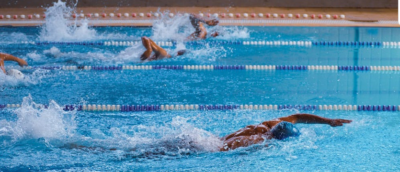 A competitive event – sponsored by BAD So our ask is this: immediate stability—40 hours of pool time this fall. And longer-term, a better process for allocating public sport resources that reflects the realities of community-based youth programming.
This isn’t about being chosen over another club. It’s about being given a fair chance to be considered—something every community organization should expect when applying to use city-owned public facilities.
We’re asking you to lead—not just with policy, but with principle. It’s not too late to apply the simplest, most universal principle in situations like this: do no harm. Especially not to children, especially not through bureaucratic oversight.
This is your chance to send a message: that in Burlington, we protect legacy, we honour fairness, and we show up for our kids.
The delegation has been edited due to space restrictions and clarity.
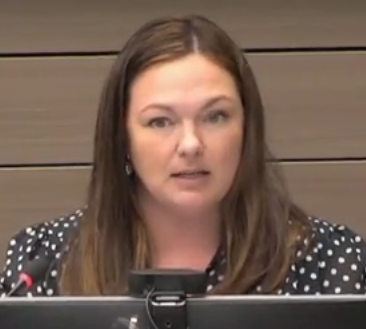 Chair of the Standing Committee that heard the delegations: Ward 2 Councillor Lisa Kearns. Chair Lisa Kearns: Okay, so you’re going to pause. I’m going to look to committee for any questions. You’re going to stay and answer the questions. Okay, okay. You will not be asking questions of staff either. Don’t ask questions back. Okay?
Councillor Stolte: My question is around any advice you have for us, around a better process than an RFP to allocate scarce Pool time,
Lebel: a rental agreement at the end of the day. I think the RFP just does not capture the ability to there’s no waiting for community legacy, and I don’t think that it’s able to capture the difference between that community model versus the market based model that we’re starting to see show up, and that’s going to be a broader problem across sports, so potentially a pool rental procedure. I think there’s other ways. Historically, my understanding is that this is a relatively new process that’s been applied. It started in 2020 I’m not sure what was done, but sure what was done before that, but potentially going back, I do think there’s room for more, different models in our ecosystem. We have a wait list of over 150 swimmers. So there’s a there’s a huge demand for swimming, but I don’t think that we can have one at the expense of another.
Stolte: Well, are you and your I don’t know if you’re speaking for the club, but would you be willing to speak with our staff and other people who want access to Pool time to sort it out? That’s how we do it with some of the other sports is that a viable way forward?
Lebel: Yes, our goal is to protect the kids. This has been, horrific for these kids, and we need to do better for them.
Chair. Thank you so much for your delegation. I just wanted to ask a quick point of clarification. I’ll ask, to to expand on it. But did you say that it’s your understanding that it’s only the swim clubs that are put through this RFP program that is our understanding? If you go through the language, I’ve pored through this for the last week, it’s very much more of a construction contract, honestly, which is fine for some processes, but again, it just does not reflect youth sport
Councillor Bentivegna: Just a quick question with regards to follow up from Councillor Stolte prior to 2020 Can you tell us how things proceeded?
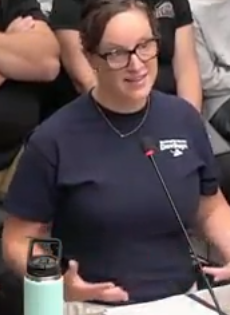 Katie Lebel Lebel: Don’t have that history.
Bentivegna: Okay, so membership, how many swimmers?
Lebel: We’ve got 400. Our pool time program is based on the amount of the allocated time that we’re given by the city. We are not in a growth mindset. We’re doing what we can with the number of hours we’re provided by the city.
Bentivegna: 400 swimmers. Has that been consistent?
Lebel: Yes, we’ve got a wait list of swimmers now that’s divided up between pre competitive and competitive. We’ve got about 85 pre competitive swimmers. It’s generally competitive swimmers, and 85 not pre competitive.
Chair Kearns: Last question; I’m not sure if you can answer this, but if everything proceeds as is, what happens to that?
Lebel: I’m not sure we’re able to exist.
Chair Kearns: I’m going to ask one question of you; we’re going into closed session for potential update on litigation, as it says in the statement on the public agenda. In that regards, do you have any potential litigated, avenues that you’re looking to explore? Just a yes or no.
Lebel: Yes?
Chair Kearns: Okay, thank you very much. I don’t have any other questions for you as a delegate. Thank you for joining us.
Lebel: Thank you very much for the time to share our story.

 By Pam Pitz By Pam Pitz
July 8th, 2025
BURLINGTON, ON
At the risk of taking too much of your time and that of those copied on this email string, I felt compelled to highlight a few things that may have been missed or could use some emphasis following this morning’s council meeting. I think this is a learning experience for many including a better understanding by council members of the long term effort a swim club must make if they are to develop kids from recruitment (age 6 or 7) through to 18 years of age and overall success. The kids need stability, trust, and a sense of belonging to be the best that they can be. I am sure we all agree it isn’t about the clubs – rather, it’s about the children who need to be assured that common sense and fairness will prevail. Please be assured the overall BAD family wants the best for Burlington kids — it has been the club’s mission for decades having spoken to swimmers who have supported the club throughout its history.
1) While GHAC suggested had they not been excluded from Burlington pool allotment in 2020, they would have lost less Burlington kids, could have recruited more and, in turn, justified more Burlington pool time. They are clearly giving the impression that they had a large number of kids from Burlington in 2020, however this appears overstated. BAD has always been the club of choice in Burlington. Why? Because BAD has always represented Burlington kids with:
-
- Burlington hosted swim meets that attracts visitors to the city;
- Burlington community involvement,
- Burlington pride, signs and BAD swim gear as it travels.
- A name that speaks to its origin — BURLINGTON Aquatic Devilrays
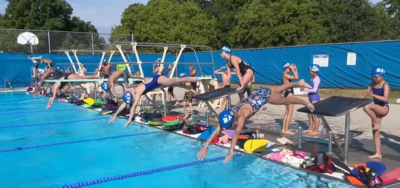 BAD swimmers in a training session It is clearly a Burlington identity with a long history. I might add GHAC’s creation in the first place was to respond to community needs in the Golden Horseshoe. They explained that today. Maybe these communities didn’t have the size or amenities to support a dedicated club like those that have existed for many years in Hamilton, Burlington, Oakville, Milton, etc. where taxpayers pay for such benefits. Across the Province most cities have long histories with one major club representing their community – it’s the essence of community pride and competition. Further, poaching kids from Burlington, Hamilton, Oakville, etc., as a regional team is not consistent with swim team etiquette. This situation is grabbing the attention of other sports/clubs in Burlington and elsewhere – if it can happen to BAD, whose volunteers, coaches and kids have worked hard for decades to build a successful, respected club, it can happen to them.
-
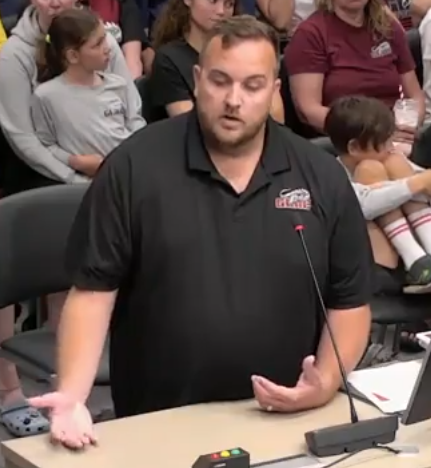 Based on their suggested numbers, the math would suggest they don’t need the pool time requested as compared to BAD’s needs. Even if one buys into the GHAC argument that they have about 28% of their swimmers from Burlington based on their suggested numbers, the math would suggest they don’t need the pool time requested as compared to BAD’s needs. BAD’s numbers are approaching 2.5 times those of GHAC when it comes to Burlington swimmers. Actually, common sense would suggest if GHAC’s Burlington swimmers wanted to swim in Burlington pools, rather then having over 400+ BAD kids move to GHAC or elsewhere, the less disruptive step would be to have GHAC Burlington swimmers move to BAD who would need a much more modest increase in pool time to accommodate them.
3) There is no policing of where swimmers come from for practices. Obviously policing the numbers is something the City cannot cost justify. GHAC wants pools, like Centennial, to run meets and to give them more pool time. Swimmers in all clubs are typically clustered around age and/or swim times with seniors allotted the better pools/facilities – like Centennial. Clustering serves to ensure the best coaching (limited) is given to them as they pursue the culmination of their competitive swimming efforts before college. It allows them to learn and feed off one another. I am sure, over time, this clustering will occur with GHAC and swimmers from other communities will be brought to practice in Burlington pools — pushing other Burlington swimmers to travel outside of Burlington or limiting the room for more Burlington recruits. Otherwise, why does GHAC need all the time they requested?
4) Please understand, even if all BAD swimmers went to GHAC, there is no benefit for BAD kids. The coaching at BAD, its reputation and successes are arguably better and the evidence shows the cost for BAD recruits is substantially lower — making it more accessible for kids with parents on limited budgets.
For the moment, let’s assume the coaching is comparable, however there are many other important points of impact :
In summary, there is NO benefit to BAD swimmers and particular to those in Intermediate and Senior levels who are focusing on the peak of their swimming careers, potential scholarships, etc.
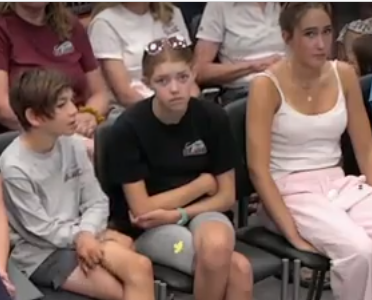 There are the personal relationships among the swimmers. They are supportive, feed off of each other, learn from each other, and bring healthy, well understood rivalry – often growing up together as their best friends. 5) No club can bring success in five year intervals. No kid can adjust because of regional expansion of an out-of-town association that brings unnecessary change in five year allotments. These kids are very impressionable, especially in the preteen and teen years. We all realize how experts caution parents in this regard. Kids have growth spurts, injuries, personal challenges at home, temporary distracting events, and many other factors that the coaches and club understand for each and every kid. This understanding develops over time and increases in intensity as the years pass by. They know the kids’ strengths and weaknesses by swim stroke, training habits, personalities, etc. The kids understand each coach’s disciplines, techniques and communication styles. Bonds form. Trust develops. It’s critical that the evolution of these relationships is protected and the results preserved, especially in the later years of the program. On top of this, there are the personal relationships among the swimmers. They are supportive, feed off of each other, learn from each other, and bring healthy, well understood rivalry – often growing up together as their best friends. They understand each other in terms of competitive swimming sacrifices and routines. These kids cannot be expected to embrace disruption every five years.
Fresh ideas are brought in by BAD and probably GHAC. BAD sources guests like current Olympians, sports psychologists , nutritional experts, and arranges professional land training, etc. BAD knows the importance of stability and trust and so does GHAC. That is what disappoints the most. If the number one priority is the kids then clubs like GHAC should focus on the communities they serve based on their original concept and market and stop encroaching on other proven clubs and communities. Taken to the extreme, regional expansion effectively eliminates competition except from within. That is not what underpins any competitive sport — rather, competition is nurtured through community pride and involvement.
Please consider these heartfelt, sincere and rational points of view. I am reminded of a T-shirt you often see parents wearing akin to “soccer moms”. It says something along the lines of, “Swim Mom” – 1000 hours of practice, one hour of warm-ups and 30 seconds of competition. Of course, longer races do exist but one can understand the point. In swimming, in particular, a hundredth of a second can make all the difference. That is why long term bonds, consistency and trust from the clubs and coaches is key along the development journey – it’s constantly tweaking based on the in-depth knowledge of each swimmer by the coaches. BAD has spent 40 plus years doing just that in Burlington.
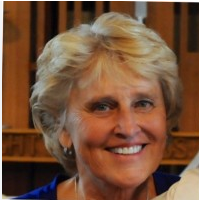 Pam Pitz There is nothing to be gained by radically diminishing or eliminating BAD in favour of a club who represents other communities and is currently operating within them. It was their choice at inception. BAD’s choice was Burlington and they enjoy the majority of Burlington competitive swimmers by far.
If this current ruling prevails it will mean a huge loss for the BAD kids and is not consistent with the “no harm” principle that was shared today.
Respectfully,

 By Joseph Gaetan By Joseph Gaetan
July 7th, 2025
BURLINGTON, ON
Having followed the Committee of the Whole (COW) meeting this morning, it was impossible to ignore the emotional weight carried by the young swimmers in attendance. Their long, sad faces told a story that no statistics or procurement policy can truly convey. The decision by the City of Burlington to deny the Burlington Aquatic Devilrays (BAD) pool time has had a tangible and heartbreaking impact.
 Members of BAD – not looking very pleased with what they were hearing. Beyond the procedural and legal questions, the human cost of this decision is quickly becoming irreparable. BAD is home to approximately 400 swimmers, with an additional 100 on a waiting list. These are not just numbers—they represent children, families, and years of commitment to a sport that thrives on stability and community. With the shift to Golden Horseshoe Aquatic Club (GHAC), many of these young athletes now face uncertainty, possible exclusion, and disrupted athletic development.
GHAC’s model appears to depend on absorbing swimmers from BAD in order to fulfill contract requirements. This has led to a situation that one councillor aptly described as a ‘zero-sum game’—where one club’s gain is another’s loss, and in this case, the most immediate and vulnerable losers are the children. Some families have already begun to exit BAD simply because they can’t wait for clarity. That is the real damage, and it is already happening.
It also remains unclear whether the Request for Proposals (RFP) approach was appropriate for this type of community service. There were hints from many that a negotiated process might better serve the community. As it stands, staff have entered into what appears to be a binding agreement with GHAC, while BAD may well have a legal basis for judicial review in Superior Court. If the City can find a resolution outside of court, it would likely result in fewer losers and a faster path to healing.
Key questions remain unanswered:
-
- Why was the RFP process used instead of a negotiated renewal?
- Would renewing BAD’s contract have caused less disruption and harm to swimmers?
- Will the GHAC model result in significantly higher program fees for families?
- Most importantly: if BAD’s application was never opened, how could the City disqualify the bid based solely on a document that does not exist under Ontario’s nonprofit regulations?
 Kimberly Calderbank This last question strikes at the core of the issue. If the rejection was based on a misinterpreted or impossible requirement, it suggests a critical failure in process and oversight. BAD submitted a valid Certificate of Status—the only up-to-date, official proof of incorporation available. Still, their application was dismissed out of hand.
What is at stake is not just pool time, but trust—between the city and its residents, between young athletes and their mentors, and between elected officials and the community. Rebuilding that trust will take time, humility, and, most importantly, action.
The city must act quickly and decisively to mitigate harm and restore confidence in its leadership.

 By Pepper Parr By Pepper Parr
July 7th, 2025
BURLINGTON, ON
Revisions: Pam Pitz will not be delegating on behalf of the Devilrays. Kimberly Calderbank, will delegate on the confidential legal report on potential litigation for aquatics procurement.Katie Lebel and Piers Allington will both delegate on the same issue.
Colleen Bent will delegate for the Golden Horseshoe Aquatic Club.
City council will learn today just what it means to have an engaged community.
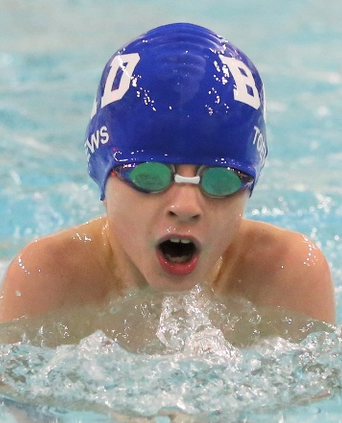 The issue is – where are these swimmers going to train? The Burlington Aquatic Devisrays (BSD) will be out in force with several delegations speaking on behalf of the Devilrays.
Kimberley Calderbank has said she would like to get everyone of the 400 members into the Council Chamber – not likely, but expect a significant turnout nevertheless.
Joseph Gaten wrote a succinct overview and outline as to just what the issues are.
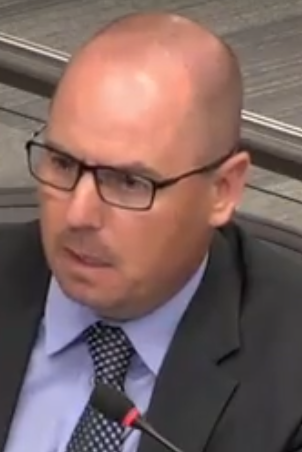 City Solicitor Blake Hurley Council is expected to go into a Closed Session during which the City Solicitor, Blake Hurley will advise on what the legal implications are on a contract award that many feel was a mistake.
Burlington has an awkward agenda procedure where they go into Closed Session during which several matters. When they come out of the Closed Session they report on any decisions they made. They seldom provide much in the way of detail.
The delegations take part at the beginning of a council meeting, which means quite a bit of time between the legal part and the public part.
Staff will be on hand to answer any questions Council members have.
The public does not get to interact with staff.
Link to the Joe Gaeten summary

 By Gazette Staff By Gazette Staff
July 5th, 2025
BURLINGTON, ON
The Gazette received the following from Cody Bradt, the Chief Operating Officer and Associate Head Coach of the Golden Horseshoe Aquatic Club.
Labeling what was sent to us as “Our Side” we were given the following:
There has been a great deal of discussion surrounding the recent awarding of the 2025 Competitive Youth Swimming RFP, and I believe it’s time we share our side of the story.
 Golden Horseshoe Aquatic Club. Throughout the RFP process, we respected the confidentiality rules and refrained from making public comments. Now that the contract has been awarded, we are able to speak openly.
First and foremost, the Golden Horseshoe Aquatic Club is not a “Hamilton club.” We are proud to serve swimmers across the entire Golden Horseshoe region—including Burlington, Hamilton, Dundas, and Stoney Creek. We’ve been part of these communities for over 20 years.
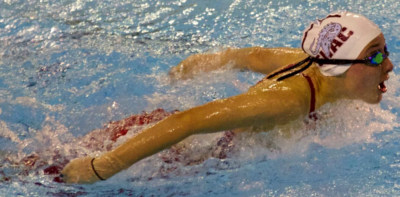 This most recent procurement process is not new. It began in 2020, following more than a decade of GHAC coexisting with other user groups. . On a personal note, I’m proud to have grown up swimming in City of Burlington pools and to have called Burlington home for more than 20 years of my life. I know firsthand the profound impact that competitive swimming can have on shaping a young person’s confidence, discipline, and lifelong friendships. It’s a privilege to now give back to the same community that helped shape me.
This most recent procurement process is not new. It began in 2020, following more than a decade of GHAC coexisting with other user groups in City of Burlington-owned facilities. When the first RFP was released in 2020, we submitted a proposal and narrowly missed being selected. We respected the outcome, requested a formal debrief, and used that feedback to improve our organization. Although we lost nearly 200 members that season, we remained committed to our mission and continued offering high-quality programming outside of city-owned pools.
It’s also important to clarify that the incumbent organization did not “lose” their pool time—they completed their contract term. The 2020 agreement was for three years with two possible extensions, and it ran its full course.
When the City released a new RFP in 2025, we again submitted a proposal—and this time, we were awarded the contract.
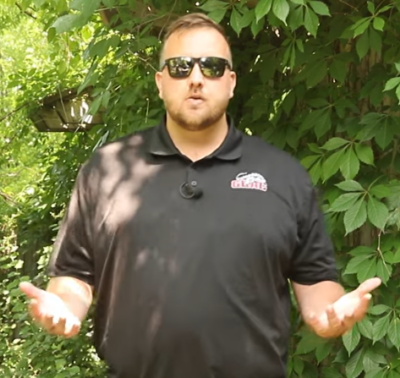 Cody Bradt – “the offer for a meeting was declined by their Head Coach.” It’s important to note that in February 2025—prior to the RFP being issued—we reached out to the incumbent organization to request a meeting to discuss the possibility of jointly approaching the City to return to a shared pool use model, as we had successfully done prior to 2020. This conversation included their Head Coach, President, and Past President.
Unfortunately, the offer for a meeting was declined by their Head Coach. We respected their decision and informed them that, in light of that, we would be submitting a proposal—just as we did in 2020.
At GHAC, we are proud to offer an inclusive program for all swimmers—including Olympic-stream able-bodied swimmers and Paralympic-stream swimmers with physical, visual, or intellectual impairments. Our organization does not distinguish between able-bodied and para-athletes. We have multiple coaches with extensive experience working with para swimmers at all levels—from those learning to swim for the first time to athletes competing internationally.
There has been some public conversation around the statistic that only 28% of our members reside in Burlington, as reported by Swim Ontario. That number reflects home addresses across our entire membership and does not accurately represent the makeup of those training in facilities in Burlington.
Statistics without context can be misleading. Over 85% of swimmers training at our Burlington practice locations are Burlington residents—and that figure has remained consistent throughout our existence.
We are a professional organization that respects every contract we hold, whether it be with municipalities, universities, or private institutions. That includes our former relationship with the City of Burlington, which we maintained respectfully from 2009 to 2020.
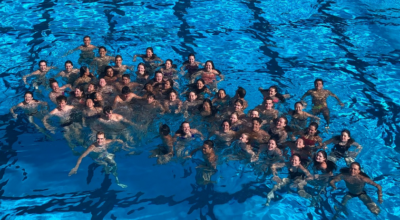 Cody Brady: “If an agreement requires that 85% of swimmers come from within a specific community, we meet that requirement.” If an agreement requires that 85% of swimmers come from within a specific community, we meet that requirement—just as we would meet a condition requiring swimmers to be able to swim 25 metres. These are simply terms we follow, and have always followed, with integrity.
We also take pride in being responsive and professional in our operations. All new inquiries receive timely responses, and we work hard to ensure that every swimmer and family feels supported.
Our experienced coaching staff brings decades of knowledge to the pool deck, with coaches who have served on provincial and national committees and represented Ontario and Canada at international competitions. Their shared goal: to better the sport of swimming for everyone.
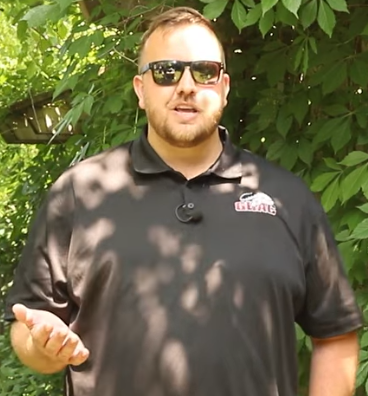 The reality is, the youth of Burlington are not losing their place to swim—they are gaining a new opportunity to continue their development with a different organization. The reality is, the youth of Burlington are not losing their place to swim—they are gaining a new opportunity to continue their development with a different organization. One that is committed to welcoming all swimmers, helping them find a group where they belong, and continuing their journey in the sport. We already have over 120 tryouts scheduled for the fall and are excited to welcome new and returning athletes into our program.
At GHAC, we will continue to act with integrity and respect. We will not engage in tearing down other organizations. Instead, we will focus on facts, solutions, and a commitment to putting the youth of Burlington first.
This is an exciting new chapter, and we look forward to supporting every swimmer through it.
There was no email address or telephone number provided for us to follow up on. We will dig around and see what we can find. The Gazette did reach out to the GHAC person for whom we had an email – there was no response.
There was a video and a second document that we will wade through this evening.
Addendum. The video was of Cody Bradt speaking the words set out in the document we were sent. Photographs were added to this article when they became available.
Mr Bradt – do send us an email address and a telephone number so that we can make sure we fully understand what you have to say. Our interest is in the interpretation you give the Swim Ontario data. You can reach me at 905-462-1948.

 By Gazette Staff By Gazette Staff
July 4th, 2025
BURLINGTON, ON
City Hall staff are reported to have not even opened the BAD application due to a missing document.
For news stories that are controversial and moving quickly it takes time for the whole story to bubble to the surface.
In a broadcast on the Cogeco Your TV channel, we learn that the people reviewing the RFP – Request for Proposal – from BAD did not even open the application that was sent in by the BAD – Burlington Aquatic Devilrays claiming it was incomplete.
In the four-minute video Mayor Meed Ward now says that she will discuss the matter when it comes up at council on Monday of next week. Up to this point, the Mayor has said Council members could be involved in RFP discussions.
Kimberly Calderbank, was front and center in the broadcast, suggesting that BAD may find itself looking for a new home.
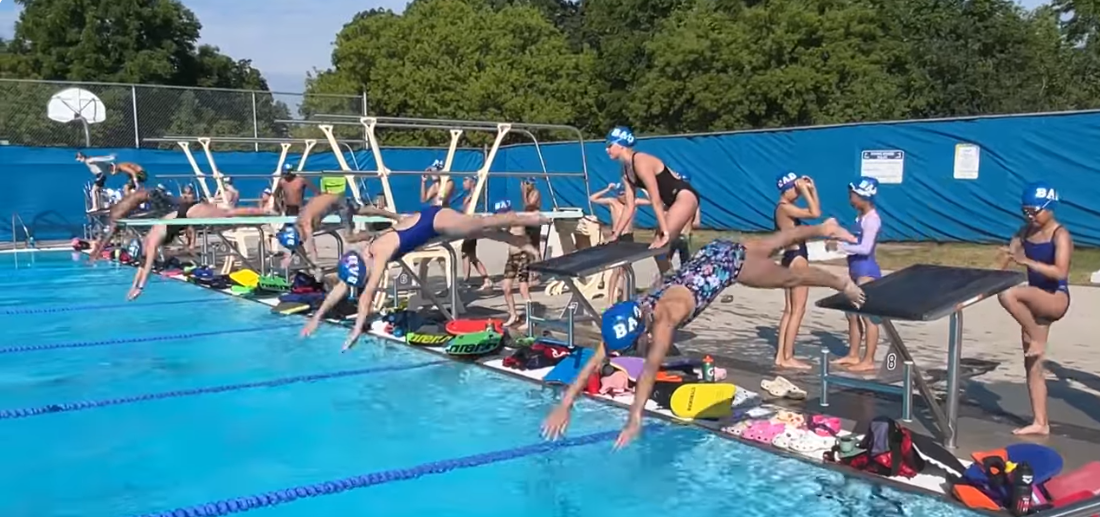 BAD swimmers in a training session at a Burlington pool The challenge for Councillors on Monday is going to be – how do they wiggle out of this mess? there are serious legal implications.
The City has told GHAC that the contract is there‘s all they have to do is show that 85% of their members live in Burlington.
The data from Swin Ontario says that 28% of the GHAC members live in Burlington.
In order to get to that 85% level, GHAC will have to poach members from BAD, which will mean putting as lot of pressure on the student swimmers..
If the city rescinds the contract (we don’t know if anything has been signed yet), that is to be awarded to GOAC – expect them to sue for breach of contract.
The YouTube video clip is HERE.
Stick around – this story is far from over.
Once Counsellor made the following comment to the Gazette:
“A bunch of years ago the City had a similar problem with allocating football fields and the use of an RFP system to solve allocation arguments. It was brought to Council, as I recall, and it was decided to not use the RFP system and just figure how to equitably share the capacity.”

 By Katie Lebel By Katie Lebel
July 4th, 2025
BURLINGTON, ON
As a follow-up to your ongoing coverage of the Burlington Aquatic Devilrays (BAD), I wanted to share some new context that will inform Monday’s Council meeting, where the club will formally delegate.
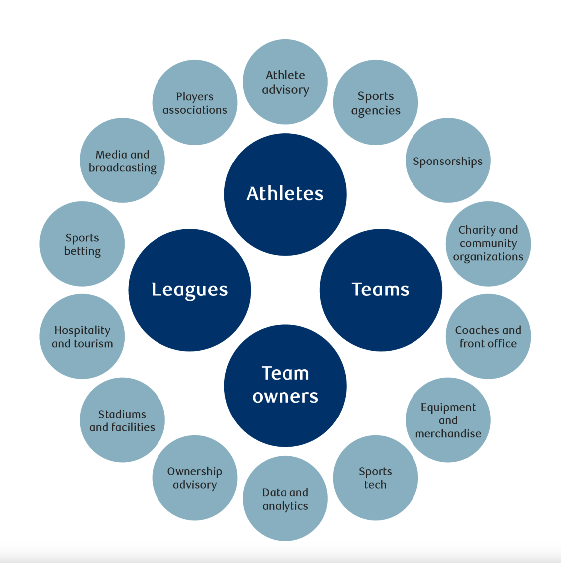 Is the Sports Eco-system in the process of changing? While the immediate issue is pool time allocation, the broader concern emerging from this case is that the City of Burlington may be unknowingly endorsing a shift toward a privatized model of youth sport — one that prioritizes market expansion over community values. BAD’s delegation will respectfully ask Council to consider what kind of sport ecosystem they want to support going forward.
Here are four key differences between BAD’s nonprofit model and the model GHAC appears to be advancing:
1. High Fee Structure
- GHAC programs appear to cost 2–2.5x more than BAD for similar age groups and training levels.
- These higher costs do not appear to be tied to more intensive programming or superior coaching.
- Instead, they seem to reflect a market-based, pay-to-play model that could create a barrier to access for many families.
- This marks a shift away from the principle that youth sport should be accessible and publicly supported.
2. Drop-In, Multi-Pool Practice Model
- GHAC swimmers reportedly attend practices at multiple pools across the region, rather than being assigned to a single site/team.
- This disrupts traditional sport development frameworks, which emphasize peer cohesion and long-term coach-athlete relationships.
- The model seems to prioritize parental convenience and consumer flexibility — echoing for-profit gym or swim lesson models rather than club sport principles.
3. Multi-City Expansion
-
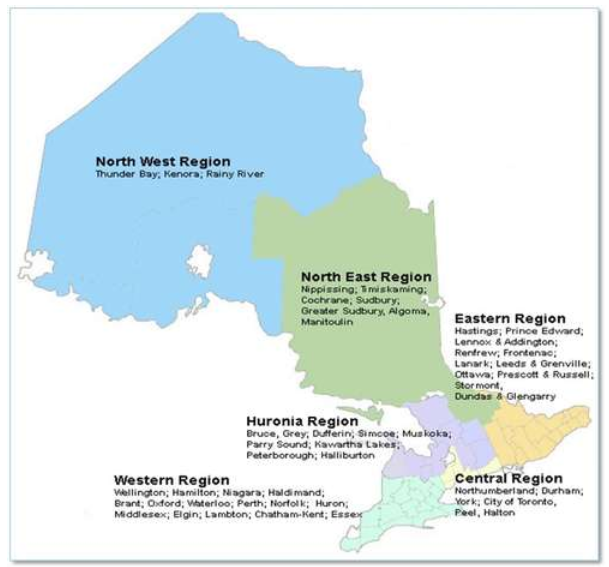 There are more than 130 swimming clubs in Ontario GHAC operates in Hamilton, Dundas, Ancaster, Stoney Creek, and now Burlington — a region-wide, growth-first footprint more characteristic of commercial expansion than community sport.
- Centralized administration and uniform branding further reflect a franchise-style approach, rather than a municipal or community-rooted one.
4. Aggressive Recruitment / Market Capture
- GHAC has begun recruiting BAD swimmers, which is viewed by many as a market acquisition tactic, not a collaborative approach between clubs.
- This raises concerns that the City’s endorsement of GHAC is enabling market consolidation, rather than fostering a diverse, inclusive sport landscape.
 We risk losing an entire philosophy of sport. 5. The Bigger Picture:
This isn’t an isolated case. The model GHAC is advancing is not unlike the rise of private swim schools like Aqua-Tots or Goldfish Swim School — both of which have steadily eroded participation in municipal swimming lesson programs by offering high-fee, drop-in based alternatives.
While these providers fill a market niche, the concern is that public infrastructure — in this case, municipal pools — is now being allocated in ways that mirror those privatization trends.
 Preserve what’s working. Why It Matters
“There could be room for both models in the sport ecosystem,” says Kimberly Calderbank. “But if the City pushes out volunteer-led, community-based clubs in favour of market-based providers, we risk losing more than just pool hours. We risk losing an entire philosophy of sport — one that values equity, inclusion, and community-building over revenue growth.”
BAD’s delegation will be rooted in gratitude, positivity, and a simple request: do no harm.
Protect access.
Preserve what’s working.
And ensure that Burlington’s public infrastructure serves all families — not just those who can afford to pay more.
Katie Lebel is a supporter of the Burlington Aquatic Devilrays.

 By Louie Rosella By Louie Rosella
July 4th, 2025
BURLINGTON, ON
In its Live and Play Plan, the City of Burlington calls Sherwood Forest Park a “major destination” park in the city.
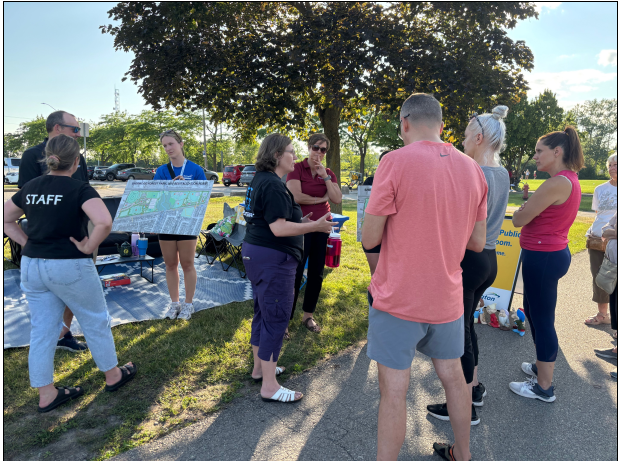 It was a small group – the biggest concern seemed to be space for cricket games to take place. Thursday night (July 3), in the midst of rugby practices, soccer games and playground play, a few dozen residents showed up to the well-known park at 5270 Fairview Drive to hear the latest updates on the proposed amenities for the park’s “revitalization.”
The informal outdoor, “public living room” style event offered plans for the new park, including renderings of the proposed amenities.
This includes a proposed, full-size cricket pitch on the west side of the park, which would replace an existing soccer field, more parking spaces to accommodate the anticipated increase in park goers, a new splash pad, and the redevelopment of the Sherwood Forest Park Community Centre.
The redeveloped facility should include a full-size gymnasium and indoor walking track, according to City staff at Thursday’s event.
Residents in attendance had some questions about the planned cricket field, concerned that it would essentially be replacing the soccer field.
However, Ward 5 Councillor Paul Sharman said this updated plan addresses community needs.
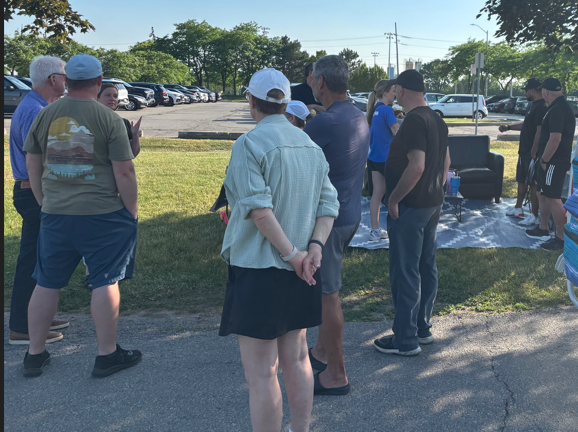 Ward 5 Councillor Paul Sharman, to the left, listening to what those who attended the event had to say. “It’s all a question of whether you live here today or you live here in the future,” he told the Gazette. “The big issue is the changing character of our population; an increasing number of people who want to play cricket.”
Demand for cricket fields in Burlington is huge, City staff said, as there is just one dedicated cricket field in the city, located in Central Park.
Sharman said if residents were to walk around their neighbourhoods on the weekends, many would see the baseball diamonds being used for playing cricket.
Other residents, including Margaret Hughes, expressed concern that there was no immediate consideration being given to lighting the pathways that run through the park.
“In the winter time, people are walking through here in the dark at 5 p.m.,” she said.
City staff said lighted paths, ironically, can create safety issues, as the dark patches between lights create shadows that present hazards, such as hiding uneven pavement, ice patches, or even a potential attacker.
“Clearly safety is the priority,” Sharman said. “You look at the playgrounds. We turn the lights off at 11 p.m., for that very reason because we don’t to have people out there drinking beer and making noise in the middle of the night.”
Hughes and others understand the need for more cricket fields in the city.
“We’re running out of space in Burlington,” she said.
So, when could the cricket field be up and running?
“It’s dependent on a grant coming from the provincial government,” Sharman said. “We’re not expecting to get that answer for a number of weeks.”
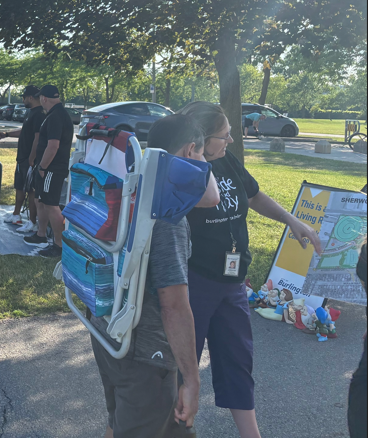 City Staff member explaining the big picture to a resident. Burlington has applied for a grant from the province’s Community Sport and Recreation Infrastructure Fund to help fund the Sherwood Forest Park project.
Development of Sherwood Forest Park is being guided by the 2016 Sherwood Forest Park Revitalization Plan; the City recently made major investments on the east side of this park by upgrading the ball diamonds, playground, and other features, the City said.
Sherwood Forest Park is located next to the Appleby GO Major Transit Station Area (MTSA), which is expected to experience significant population growth through intensification, the City said.
The City’s Live and Play Plan, which the City says is designed to ensure Burlington continues to grow as a sustainable, vibrant, and economically strong community, identifies Sherwood Forest Park as a “major destination” park.
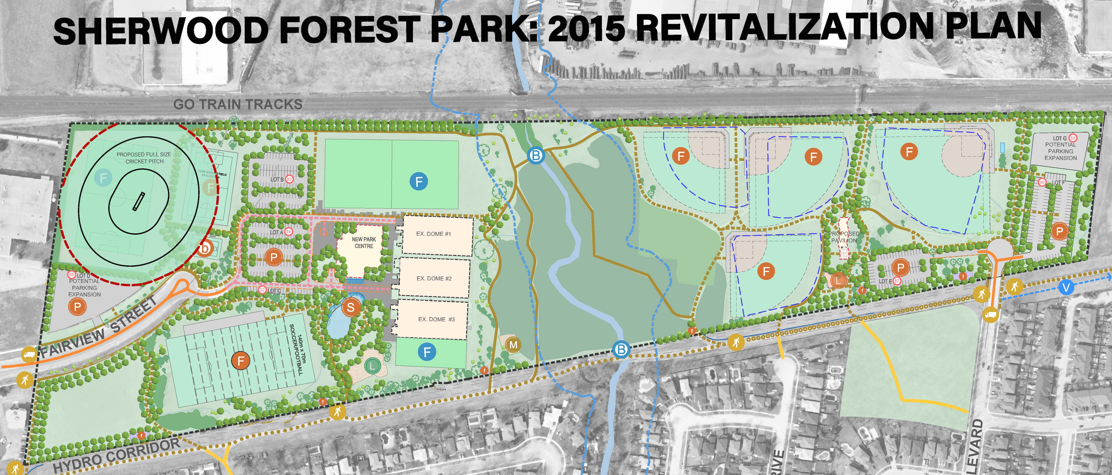
Louie Rosella is a professor at Humber Polytechnic and a former journalist in the GTA.

 By Pepper Parr By Pepper Parr
July 3rd, 2025
BURLINGTON, ON
When the city announced on the Friday before the long weekend that GHAC (Golden Horsehoe Aquatics Club) had been awarded the contract – the folks at BAD (Burlington Aquatics Devilrays) were close to frantic.
The media release explained the decision they made which included the following:
As part of the evaluation criteria, the RFP required all applicants to demonstrate that at least 85% of their registrants live in Burlington. This is to make sure that Burlington residents benefit directly from the pool time the City provides. GHAC met all the requirements of the proposal, including this residency threshold, and has been awarded the contract.
 Kimberly Calderbank, volunteer president of the Burlington Aquatic Devilrays – is fighting to keep her organization alive. When Kimberly Calderbank, volunteer president of BAD saw that statement she immediately reached out to Swim Canada, the regulatory body for competitive swimming in Ontario, for data on the BAD membership and the GHAC membership.
Swim Canada confirmed that
79% of the BAD membership lived in Burlington and
that 28% of the GHOC membership lived in Burlington.
Later the same day the city sent out a second media release (5:36 pm on a Friday before a long weekend)
The content of both media releases were identical except for the one paragraph related to membership levels.
In the second media release the city said:
As part of the RFP process bidders were required to demonstrate how their organizations will ensure 85% of participants are Burlington residents. The successful bidder – GHAC- demonstrated that it could fulfill this requirement upon service commencement in September 2025. Further, the successful bidder will be required to validate this requirement in September, and annually thereafter. This is to make sure that Burlington residents benefit directly from the pool time the City provides. GHAC met all the requirements of the proposal, including this residency threshold, and has been awarded the contract.
Saying that an organization could fulfill a membership requirement stands in contrast to an organization that has already met the requirement.
BAD has retained legal counsel.
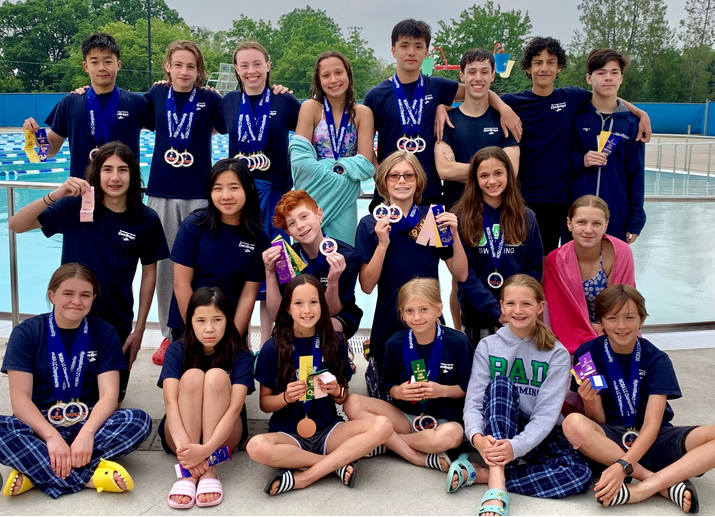 The 400 members of the Devilrays show that competitively they are winners – the city doesn’t seem to see them the same way. At a scheduled city council meeting, there is an item on the Confidential part of the meeting
Something that could have and should have been worked out at an administrative level is now in the hands of the lawyers.
 City CFO Craig Millar: Is this the level at which the pool allocation problem should have been resolved? Did the issue ever get to this level? The procurement staff involved in this matter are said to be away on vacation. They come under the supervision of the CFO Craig Millar, who is new to Burlington. The procurement people should have brought the CFO into the picture.
The Gazette reached out to a resident with years of experience dealing with RFP’s – Requests for proposals. Here is what he had to say about this situation:
On the Resident Priority part of the RFP – “Demonstrate how your organization will ensure a minimum of 85% of participants are Burlington residents.” Use of the word “will” means in the future, the requirement is not to have 85% now or at the time of submission. If the city did not have this wording, the incumbent vendor would be the only vendor that qualified, removing the competitive nature of the process.
In the requirement to produce documents: “”bids must include current and valid certificate of incorporation as a Non-Profit or Not-for-Profit organization.” Our expert asks: How did the Golden Horseshoe group comply if the form, as the Devilrays claim, does not exist?
“The contract will be for a First Term of three (3) years with two (2) optional extensions of one (1) year each based on the same terms and conditions and upon mutual agreement between the Vendor and City and contingent upon a sufficient budget and/or Council approval if applicable.” As suspected, the contract is for five years.
“The hourly pool time fee accepted pursuant to this RFP will include:
- The supervision of two (2) City of Burlington Lifeguards for indoor pools
- The supervision of three (3) City of Burlington Lifeguards for outdoor pools.”
Our expert suggests “This wording does make the RFP look like a pool rental agreement, not the purchase of something by the city that would fall under “procurement”.
“The Pool User must commit to a minimum of 2,000 pool rental hours annually at a rate of $110.00 per hour. This hourly rate will be adjusted each September based on the Consumer Price Index (CPI) plus 1% for the duration of the agreement.”
Again from the expert: This works out to $220,000 – so the “winner” commits to buy $220,000 a year of pool time from the city.
My conclusion – this is a facilities rental agreement and should not be classified as procurement. Council can and should be involved in the decision-making.

 By Staff By Staff
June 16th, 2025
BURLINGTON, ON
The Beachway and that little slip of a beach at the bottom of Brant Street are open for swimming.
Testing for E coli takes place regularly
Beachway Beach in Burlington (1094 Lakeshore Road) tested safe for swimming on June 11
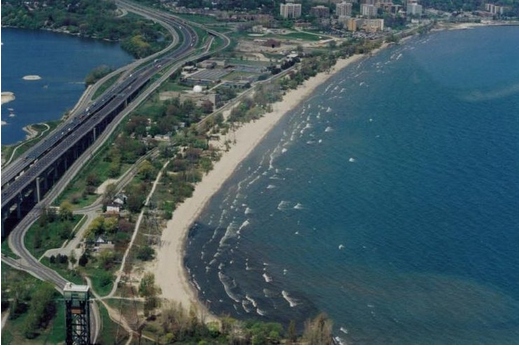 Lake Ontario is still quite cold – it tends to warm up nicely in August. Brant Street Beach in Burlington (Lakeshore Road and Brant Street) tested safe for swimming on June 12
 This mini-beach on the west shore side of the pier was created naturally by sands that came from as far away as the Scarborough bluffs. It was upgraded when Michelle Benoit, a local swimmer, attempted to swim from Port Dalhousie to Spencer Smith Park in 2012. Heavy waves brought the attempt to an early end. 
 By Pepper Parr By Pepper Parr
June 16th, 2025
BURLINGTON, ON
OPINION
The criminal trial of the five hockey players accused of sexually assaulting a woman has ended.
The Crown has presented its case, and the Defence has put forward its arguments.
 Justice Carroccia Justice Carroccia will deliver a verdict on July 24th.
The public has heard far more than they wanted about the antics of boys who were headed for fame, celebrity and annual incomes in the millions, driven by their gonads.
Whatever the decision, it may well be appealed.
We know far too much about what they are accused of doing. As described during the trial – this was disgusting behaviour.
As I followed the trial, I found myself wondering – what do the parents and grandparents of these boys say to their friends and associates about the behaviour?
 We know that Hockey Canada, the national governing body for grassroots hockey in the country, used funds provided by parents to pay out hush money to women who filed complaints. We know that Hockey Canada, the national governing body for grassroots hockey in the country, used funds provided by parents to pay out hush money to women who filed complaints.
The outrage over that practice was so strong that the federal government cut off its Hockey Canada funding and sponsors walked away from the table.
Hockey Canada got a new board and cleaned up their act.
The remark that came from the National Hockey League about whether or not the five boys (now young men) would be able to play in the NHL even if they were found not guilty – reset what is acceptable behaviour and what isn’t.
The parties that took place were not something new. They had been going on for years – they were looked forward to as a sort of “coming out” in the hockey business. Young women were as involved as young men.
The question I found myself asking is – who is going to set the standards for the sport?
Could it be that the NHL will determine what the social values are determine what is acceptable?
In the Armed Services, there is a phrase: “prejudicial to good order and discipline” a catch-all provision, used to address misconduct not specifically covered by other offences.
Offences that are prejudicial to good order and discipline can result in disciplinary actions, including summary trials or courts-martial, and potentially lead to penalties such as dismissal with disgrace from Her Majesty’s service, fines, or imprisonment.
 NHL Commissioner Gary Bettman In February of 2024 NHL Commissioner Gary Bettman said he does not believe the NHL players facing charges will return to their NHL teams this season.
It appears that Bettman might be prepared to rule that the players never return to the league.

 By Nicolai Ryan Klausen By Nicolai Ryan Klausen
June 16th, 2025
BURLINGTON, ON
Progressive jackpot slots breathe new life into online gambling. And when it comes to places where you enjoy such jackpots, Wildrobin casino offers its own selection of progressive slots, each with fresh designs and fun gameplay. Today, these dynamic jackpots are no longer limited to traditional slot machines. They’re now found in online slots, and even some video poker games, with prize pools shared across networks.
What are progressive slots?
Progressive slots are machines where the main prize, or jackpot, grows with each bet. When someone places a bet, a portion of this money is added to the jackpot. And it gets bigger and bigger until someone wins it.
Sometimes the jackpot can automatically “fall” when it reaches a certain amount. But more often it simply grows without limits, and you can win it at any time if you’re lucky.
 There are two types of such games: those where the jackpot is created specifically for this game; those that are connected to a common jackpot (the same prize for several slots). There are two types of such games: those where the jackpot is created specifically for this game; those that are connected to a common jackpot (the same prize for several slots).
Here’s what’s important to know about progressive slots before you go to play more than 50+ types of games in Wildrobin:
- Each bet has a small portion that goes into the common prize pool;
- This fund is visible on the screen: it is constantly updated so that everyone can see how big it is;
- When someone wins the jackpot, it starts over with a minimum amount;
- The jackpot itself is formed from the players’ money, not from the casino’s pocket. You all “collect” it together;
- Anyone can win, but usually it’s just one person, like in the lottery.
That’s it. A simple idea, but sometimes it brings someone a lot of money.
Different types of progressive slot
 Progressive jackpots have changed in recent years. Previously, jackpots were only in one game, but now they are collected from many casinos around the world. The more people play, the bigger the jackpots become and the more often someone wins them. For example, there is the Jackpot King feature from Blueprint Gaming. It shows three large jackpots at once, collected from many games at once. Progressive jackpots have changed in recent years. Previously, jackpots were only in one game, but now they are collected from many casinos around the world. The more people play, the bigger the jackpots become and the more often someone wins them. For example, there is the Jackpot King feature from Blueprint Gaming. It shows three large jackpots at once, collected from many games at once.
Here are the common jackpots:
 Game jackpot. Some games, like Ozwin’s Jackpots, have their own jackpot. It is also formed by players from different casinos. Game jackpot. Some games, like Ozwin’s Jackpots, have their own jackpot. It is also formed by players from different casinos.
Network jackpot. This is when the jackpot is the same for more than 30 different slots. That is, you can play different games, and the winnings will be from one large fund.
Multi-level jackpots. Many games have several jackpots: small, medium, and large. Small ones can be won more often, and large ones, less often, but they are very large. This makes the game more interesting because there is always a chance to win.
Time-limited jackpots. Red Tiger has come up with jackpots that are guaranteed to be paid out by a certain time of day. This means that the prizes cannot accumulate for very long; they are paid out daily.
Canadian players try out two primary categories of jackpots at Wildrobin: hot and new.
Almost all game manufacturers now make progressive slots. But the biggest jackpots are given by big gaming companies like Games Global, NetEnt, and IGT.
To cap it all, progressive jackpots are not just ordinary games; they grow in value with every spin players make. It means the more people play, the bigger the prize becomes. It’s a feature that keeps players coming back, all hoping to hit that growing jackpot.

 By Jeannie Løjstrup By Jeannie Løjstrup
June 16th, 2025
BURLINGTON, ON
Modern online casinos offer many slots that differ in theme, mechanics, and bonus options. Jackpot slots are especially popular among Canadian gamblers because they allow them to win a large prize. Many reputable online casinos, including Robocat, offer this format of gambling entertainment. In some of them, the jackpot sizes can reach millions of dollars.
What is the difference between fixed and progressive jackpot slots?
Top gambling sites, including Robocat online casino, offer slots with fixed and progressive jackpots. Below, we will explain the main differences between them.
Slots with fixed jackpots
A fixed jackpot is a specific amount of payouts you can receive in a particular slot. Usually, the limit on the win is set by the provider, but there are slots in which the online casino determines the prize amount. The size of the fixed jackpot does not depend on the number of rounds and the popularity of the slot. You need to collect a winning combination or pass levels to get the biggest win.
The most popular slots with a fixed jackpot, which are offered by a random online casino:

- Electro Coin Link. This slot from Fugaso allows players to win one of four fixed jackpots (Grand, Major, Minor, Mini), which are activated by the Running Wins bonus feature. Each of them has a fixed value, which depends on the size of your current bet. The maximum win in Electro Coin Link is up to 5000× of the bet.
- Immortal Ways Sweet Coin. You can win one of four fixed jackpots by launching this colorful and dynamic slot. To do this, you need to activate the Prize Wheel bonus feature. It is triggered by collecting six or more gold coins on the reels. RTP of the Immortal Ways Sweet Coin slot is 96.28%. Volatility: medium.
 Juicy Win. This slot allows players to win one of four fixed jackpots (Bronze, Silver, Gold, Platinum) activated during the bonus game with the Hold the Spin mechanic. You must collect three coin symbols on the reels to launch the bonus game. The maximum win is up to 3600× of the initial bet. Juicy Win. This slot allows players to win one of four fixed jackpots (Bronze, Silver, Gold, Platinum) activated during the bonus game with the Hold the Spin mechanic. You must collect three coin symbols on the reels to launch the bonus game. The maximum win is up to 3600× of the initial bet.
In addition, reliable online casinos offer other slots with fixed jackpots. The most popular are Coins of Ra Power— Hold & Win, Power Coin: Trinity Series, and Eagle Strike.
Slots with progressive jackpots
 A progressive jackpot is a cumulative prize, the size of which consists of deductions from each bet. With each game round, the size of the progressive jackpot increases. This means that the more bets gamblers make, the higher the maximum payout. Another feature of progressive jackpot slots is that winnings do not depend on the bet size. A player who has made the minimum bet can win. A progressive jackpot is a cumulative prize, the size of which consists of deductions from each bet. With each game round, the size of the progressive jackpot increases. This means that the more bets gamblers make, the higher the maximum payout. Another feature of progressive jackpot slots is that winnings do not depend on the bet size. A player who has made the minimum bet can win.
The most popular progressive jackpot slot on sites like Robocat online casino is Super Wolf from Skywind Group. It allows players to win a progressive jackpot, which is activated when five multi-colored gems fall on one active payline. The slot’s RTP is 95.34%, of which 0.4% goes to forming the jackpot. Super Wolf has medium volatility, which ensures frequent but moderate wins.
Try to perceive large prize payouts in online casinos as a way to get bright emotions and pleasure from the game, not as a source of income. Rationally manage your bankroll and adhere to the principles of responsible gaming.

 By Jeannie Løjstrup By Jeannie Løjstrup
June 12th, 2025
BURLINGTON, ON
Ontario’s online gambling industry enjoyed a record-breaking end to 2024, with Q3’s online casino spend showing a 38% year-over-year increase, amounting to $18.9 billion. This money was taken in during the 3 months leading up to December 31st, and puts the province in a healthy position for 2025.
 Since April 2022, consumers have been able to play online poker in Canada with operators who have entered into an agreement with iGaming Ontario and registered with the AGCO. Consumers can also enjoy a variety of casino games with licensed and offshore betting sites, but only revenue taken by Canadian operators is counted towards the revenue figures cited. Since April 2022, consumers have been able to play online poker in Canada with operators who have entered into an agreement with iGaming Ontario and registered with the AGCO. Consumers can also enjoy a variety of casino games with licensed and offshore betting sites, but only revenue taken by Canadian operators is counted towards the revenue figures cited.
Following a strong finish to 2024, 2025 started in a similar fashion, with online gambling enjoying a $7.84 billion handle in January, a record for the month. Of this total, online casinos led the way by taking in 83%, and 70% of the total GGR for the month. This has been put down to the excellent selection of operators and games available to consumers.
Online slots are the most popular casino attraction, but traditional table games also appeal to a lot of customers. Tech developments have helped online casinos to bridge the gap between online and in-person gambling experiences, with live dealers, AI-enhanced gaming, and state-of-the-art graphics.
Despite online casinos taking the lion’s share of online gamblers, sports betting markets have also experienced growth. The gross gambling revenue of $91.9 million for January represents a 32.2% year-on-year increase, and a 133.8% improvement on December’s figures. Sporting fixtures and events have had an impact on these figures, but operators have proven that they can capitalize on opportunities.
Some aspects of Ontario’s gambling industry are still in their infancy, with single-event sports wagering only being legal since 2021, and online betting following in 2022. However, operators have been quick to act, with more than 80 unique gaming facilities and 50 operators now in action.
 People can gamble on a game of chance from their smart phone. The success of the online gambling industry can be attributed to the estimated 14.6 million Ontarian smartphone users, roughly 84% of the province’s population. Operators are able to provide convenient gambling for customers, and bonuses, offers, and competitive odds have also been key to securing new users.
While these improving figures are great for Canadian gambling sites, they have also helped to generate significant tax revenue streams, including more than $145 million in the first quarter of the 2024/25 fiscal year. Tax revenue since 2022 is rapidly approaching the £1 billion mark, and this has benefited public services and infrastructure, healthcare, and education. The industry has also had a positive effect on employment in Ontario, with an estimated 15,000 full-time jobs being created.
The online gambling industry in Ontario and Canada as a whole is in a strong position, thanks to a well-structured regulatory framework and the dedication of operators to embrace technological developments that can improve the user experience. As the industry continues to develop, consumers can expect an even greater game choice, as well as improved payment options that can streamline deposits and withdrawals.

|
|
 By Pepper Parr
By Pepper Parr
















 By Pepper Parr
By Pepper Parr The understanding we have is that Council will go into a Closed Session – there is the suspicion that someone has taken legal action – Burlington Aquatic Devilrays (BAD) has said they have put their request for a Judicial Review on hold until they have a better understanding of what Council is going to do.
The understanding we have is that Council will go into a Closed Session – there is the suspicion that someone has taken legal action – Burlington Aquatic Devilrays (BAD) has said they have put their request for a Judicial Review on hold until they have a better understanding of what Council is going to do.
 GHAC said they are not a Hamilton swimming club – then what are they?
GHAC said they are not a Hamilton swimming club – then what are they? By Sidsel Nørgaard
By Sidsel Nørgaard


 By Pepper Parr
By Pepper Parr The Mayor didn’t say a word about this during the Standing Committee that adjourned at 2:15 this afternoon – nor was there any mention at the Special Council meeting that took place immediately after the Standing Committee.
The Mayor didn’t say a word about this during the Standing Committee that adjourned at 2:15 this afternoon – nor was there any mention at the Special Council meeting that took place immediately after the Standing Committee.








 Stolte: Second question, so the 50 hours, in an ideal world that includes the Meet time, or meet times, the meat is part of sorry, the meat was part of the contract and the RFP, so it was the 50 hours, the 2000 plus, these are the meats that you would receive for part of the RFP,.
Stolte: Second question, so the 50 hours, in an ideal world that includes the Meet time, or meet times, the meat is part of sorry, the meat was part of the contract and the RFP, so it was the 50 hours, the 2000 plus, these are the meats that you would receive for part of the RFP,. Calderbank: None, zero. So the call that I had on June 5 with the procurement team was, we’ll follow up with the sustain, substantially reduced. I’m using air quotes. I don’t know if Calvin can see me or not, but substantially reduced. Okay, substantially reduced Pool time. I did not receive that call from the procurement team or the staff that day. It was promised by the end of the week. I did not hear by the end of that week, we did follow up and had a meeting last week with Emily Renee and a gentleman as well from facilities, and had that discussion. I’m quite hopeful that it will be more than the sustain substantially reduced time that I heard about on June 5.
Calderbank: None, zero. So the call that I had on June 5 with the procurement team was, we’ll follow up with the sustain, substantially reduced. I’m using air quotes. I don’t know if Calvin can see me or not, but substantially reduced. Okay, substantially reduced Pool time. I did not receive that call from the procurement team or the staff that day. It was promised by the end of the week. I did not hear by the end of that week, we did follow up and had a meeting last week with Emily Renee and a gentleman as well from facilities, and had that discussion. I’m quite hopeful that it will be more than the sustain substantially reduced time that I heard about on June 5. Mayor Mead Ward: Thank you so much for being here, all of you for being here. So you’ve raised some concerns, as did the previous. Delegate, I around the RFP as a method for allocating scarce Pool time or really limited hours in any city facility. She said the the RFP was akin to a construction contract, so perhaps really good for potholes, not so good for people, so what? And I noted it on your your slide that that you want a different path. Can you do you have any ideas or suggestions for us around how the city might fairly allocate a scarce resource full time, recognizing that there are Burlington families that do swim with G hack currently and travel outside the city. So we’ve got, we’ve got two clubs right now that that are providing really valued service to our residents.
Mayor Mead Ward: Thank you so much for being here, all of you for being here. So you’ve raised some concerns, as did the previous. Delegate, I around the RFP as a method for allocating scarce Pool time or really limited hours in any city facility. She said the the RFP was akin to a construction contract, so perhaps really good for potholes, not so good for people, so what? And I noted it on your your slide that that you want a different path. Can you do you have any ideas or suggestions for us around how the city might fairly allocate a scarce resource full time, recognizing that there are Burlington families that do swim with G hack currently and travel outside the city. So we’ve got, we’ve got two clubs right now that that are providing really valued service to our residents. Was this decision fair and just? And everything in my fiber says this decision was not fair and just. And I’m sure everybody could agree, if you really took a look at it, it was not fair and just. So that is our next step in good faith, because I believe in this council, and I believe in the city, I’m hopeful that we can get what we need to altogether. So that review is on pause. I have a note to the lawyer. He was going to reach out to your legal team as well and advise that, as we are in negotiations or conversations here, that we have paused that, but it is something very real, and our club is willing to fight for these kids.
Was this decision fair and just? And everything in my fiber says this decision was not fair and just. And I’m sure everybody could agree, if you really took a look at it, it was not fair and just. So that is our next step in good faith, because I believe in this council, and I believe in the city, I’m hopeful that we can get what we need to altogether. So that review is on pause. I have a note to the lawyer. He was going to reach out to your legal team as well and advise that, as we are in negotiations or conversations here, that we have paused that, but it is something very real, and our club is willing to fight for these kids.

 By Pepper Parr
By Pepper Parr





 By Pam Pitz
By Pam Pitz

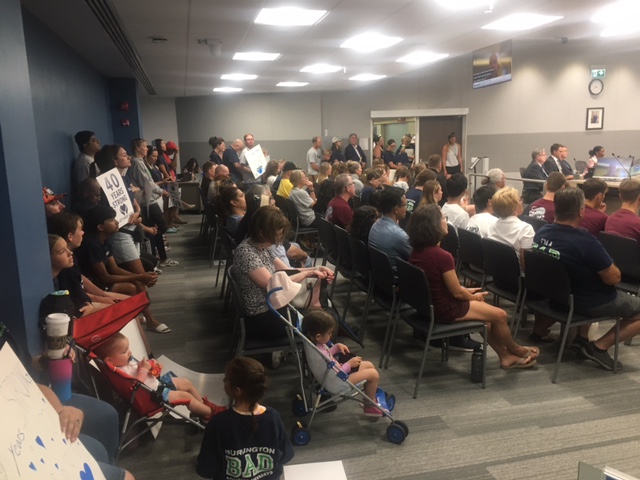






 By Gazette Staff
By Gazette Staff





 By Katie Lebel
By Katie Lebel


 By Louie Rosella
By Louie Rosella




















